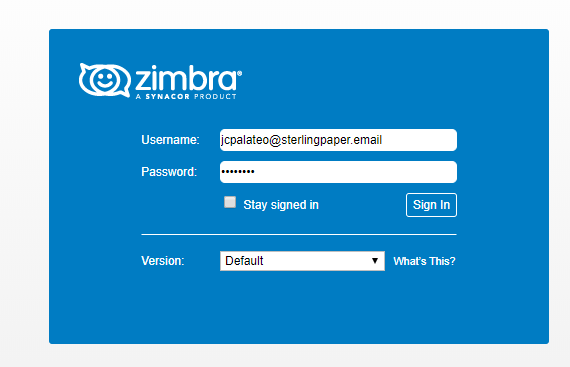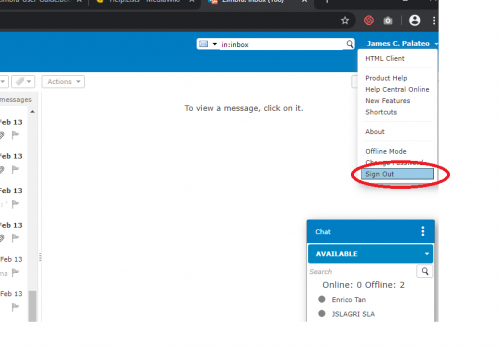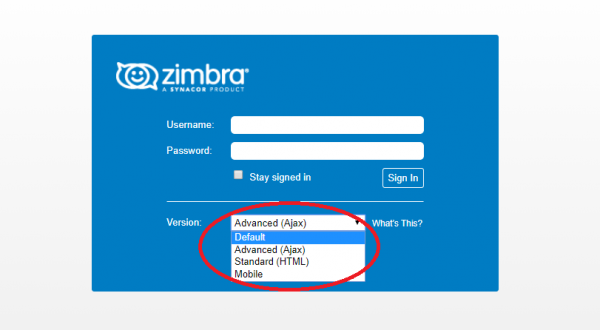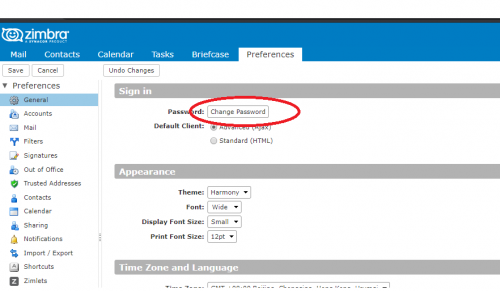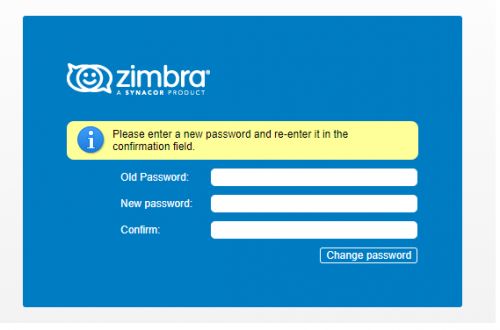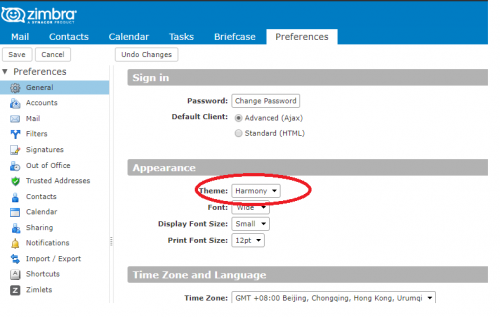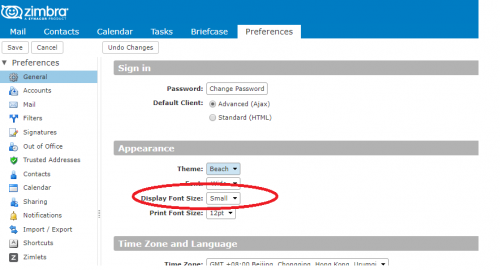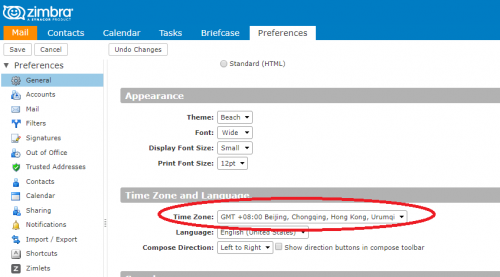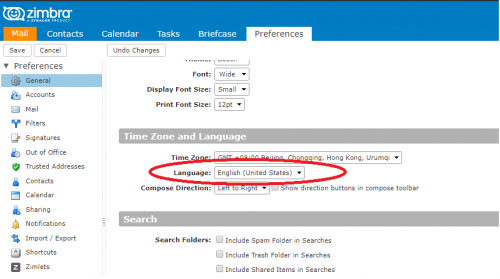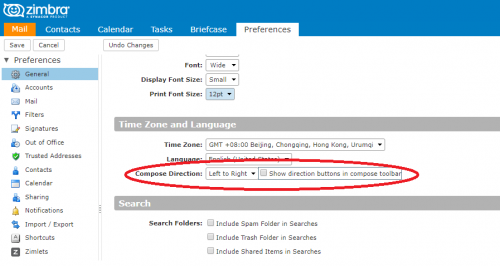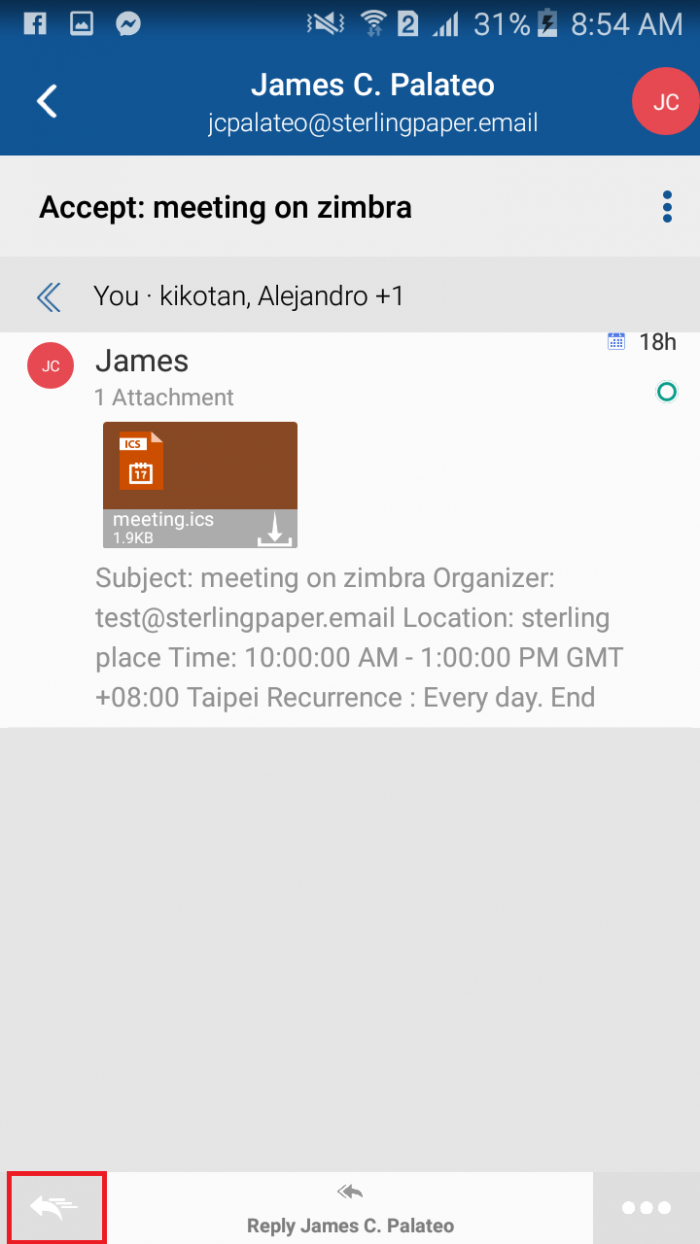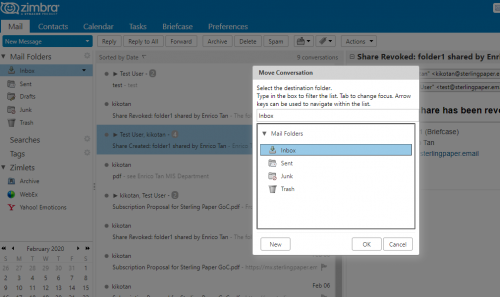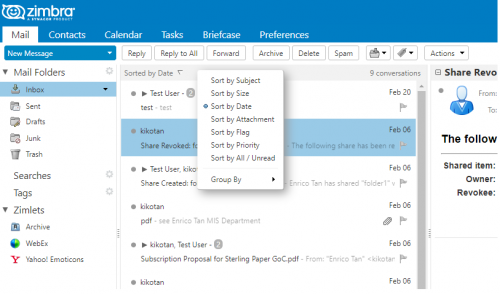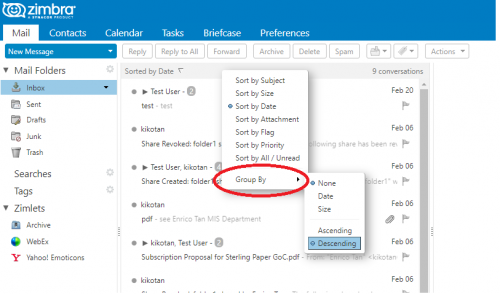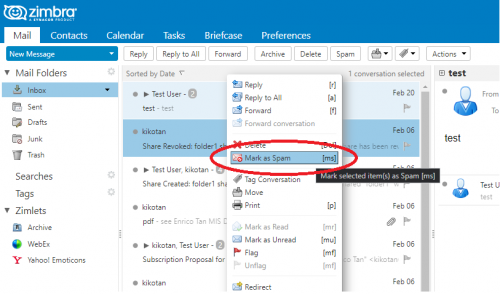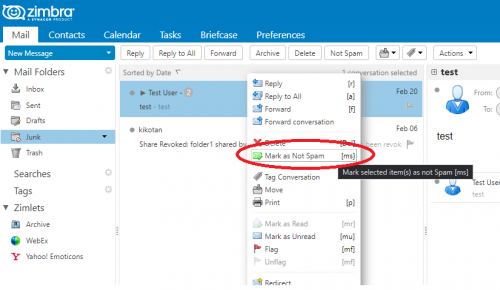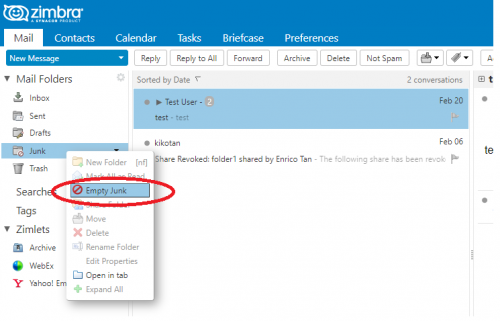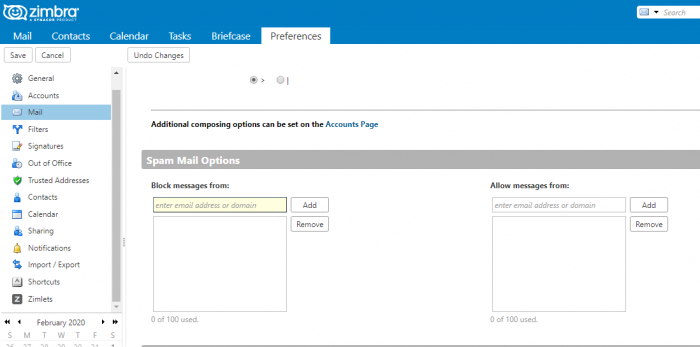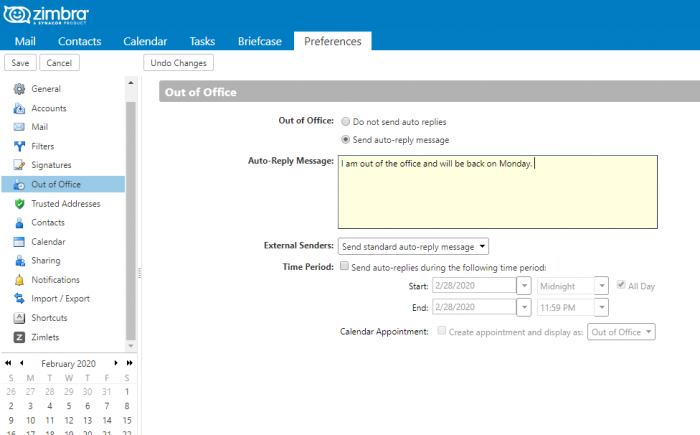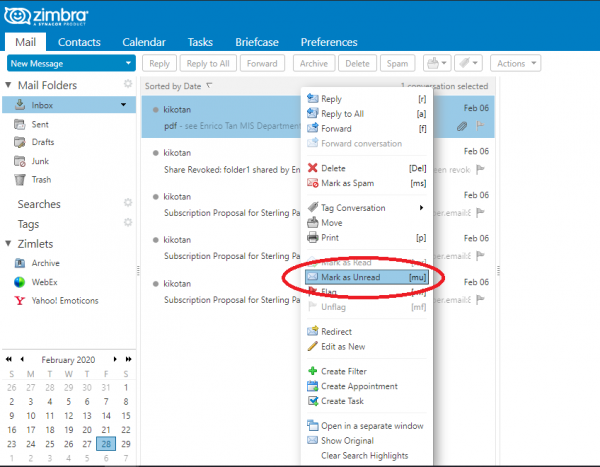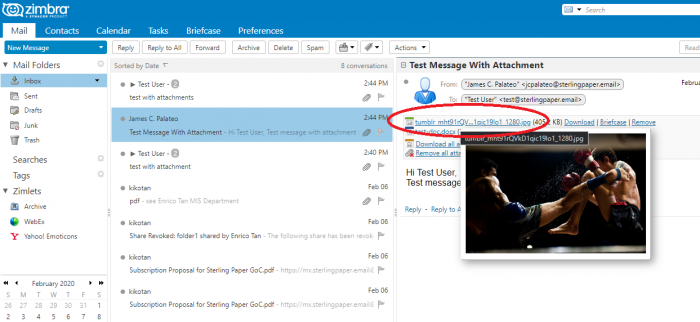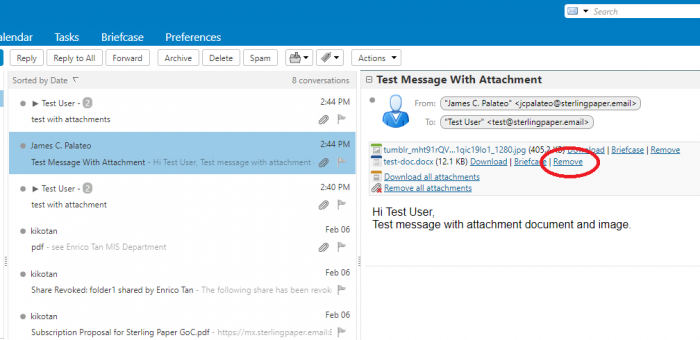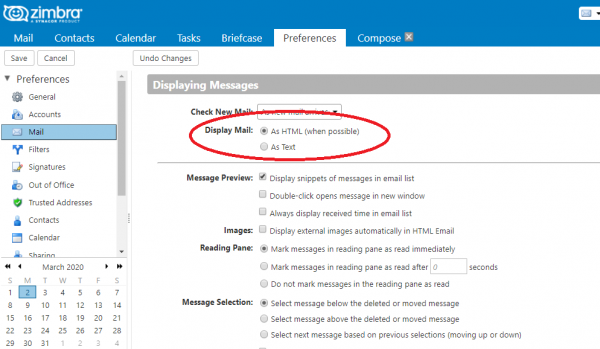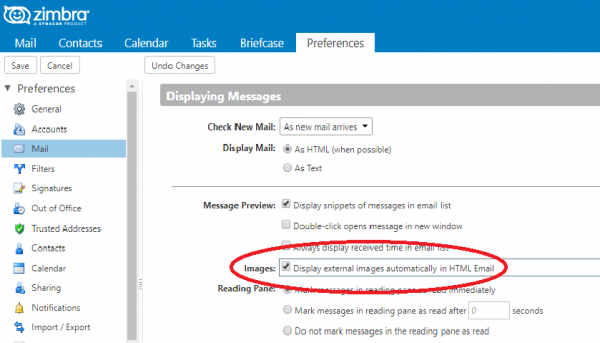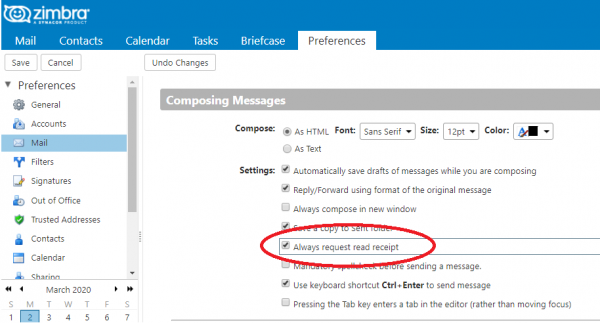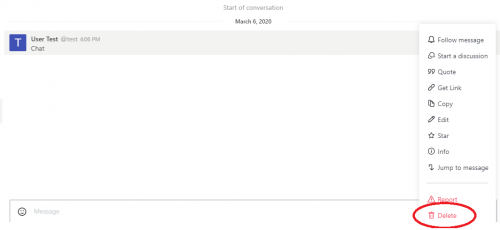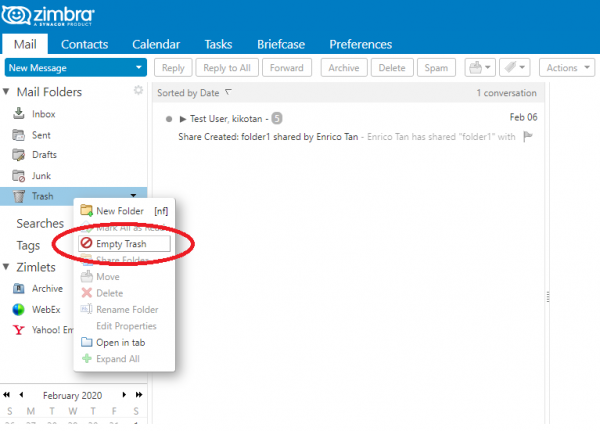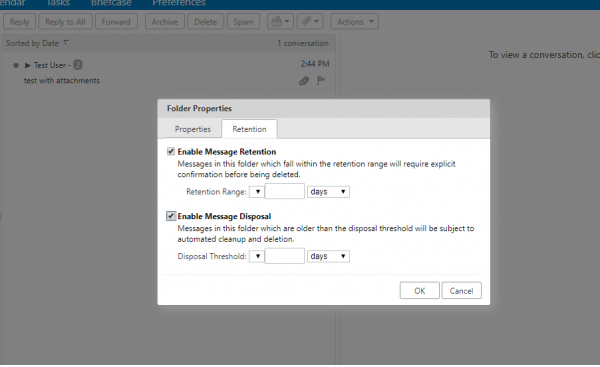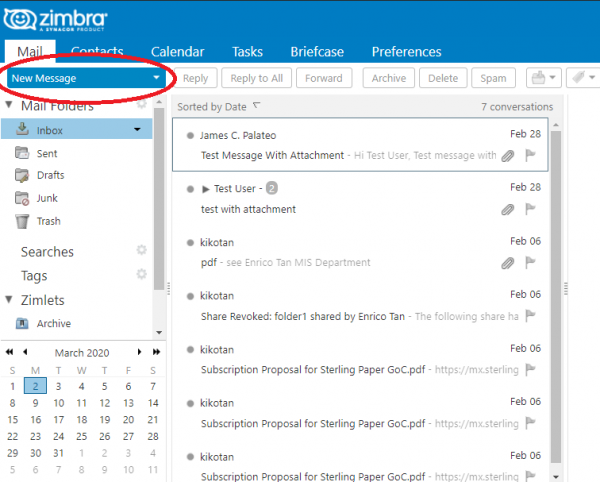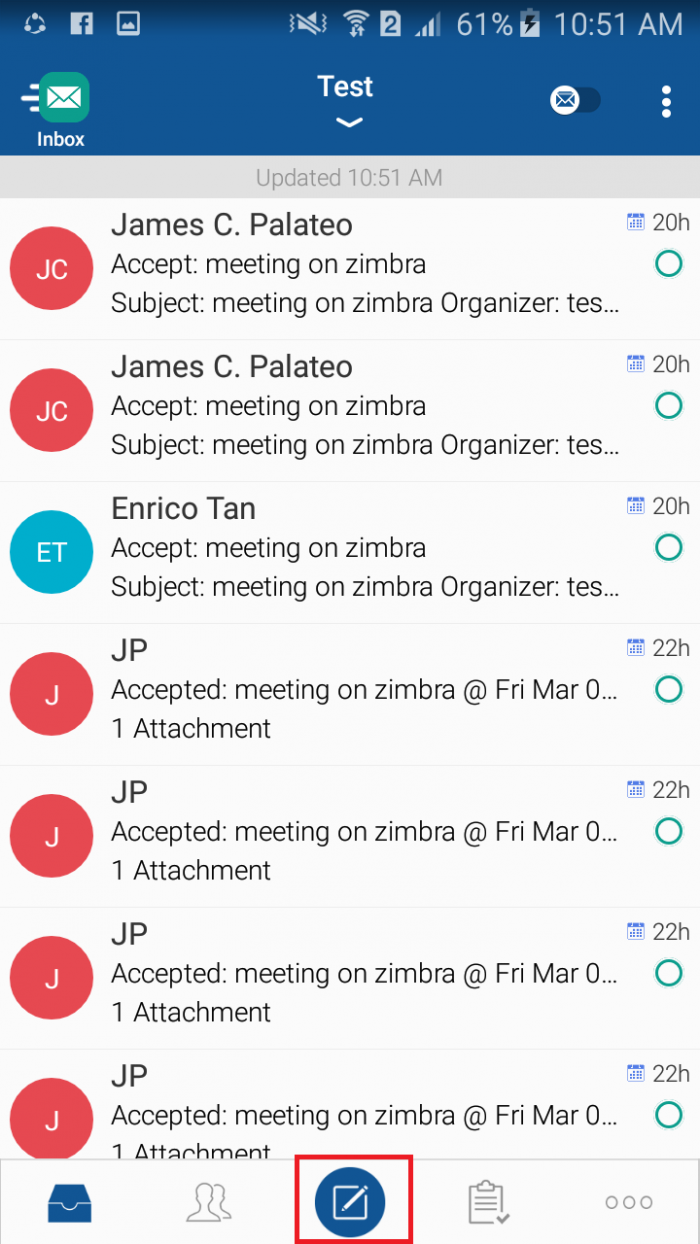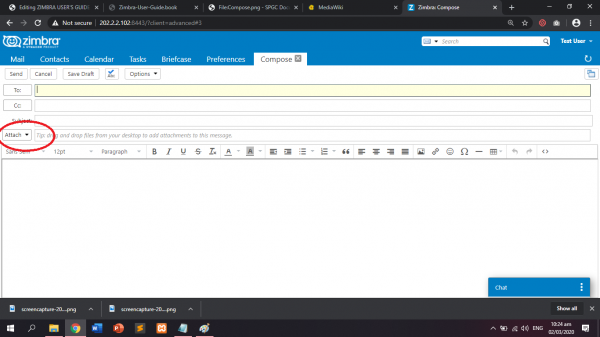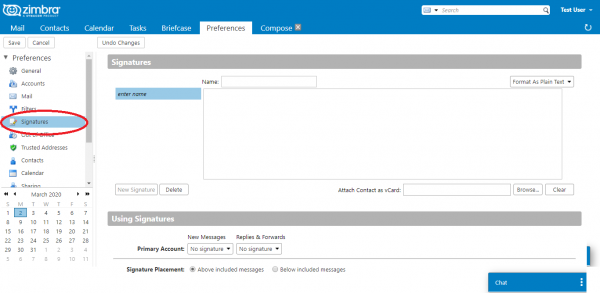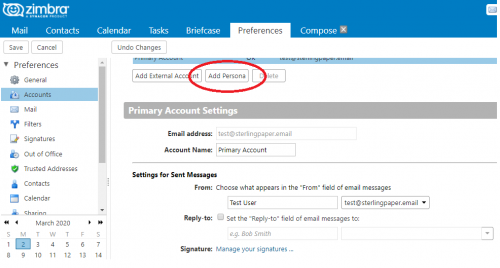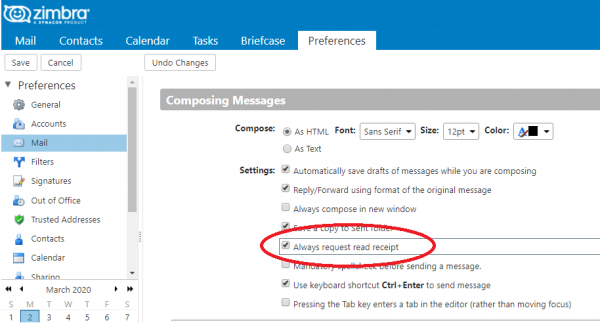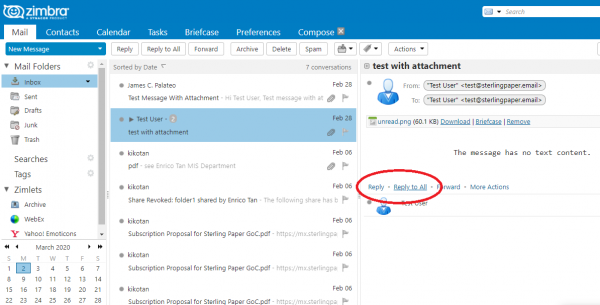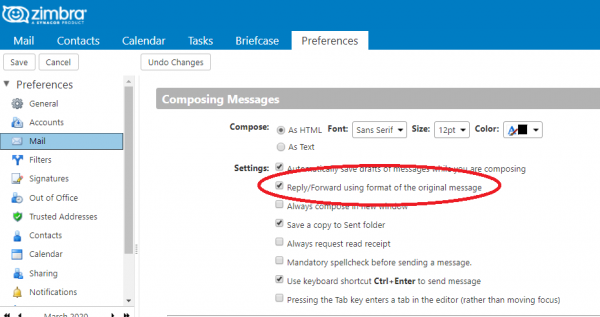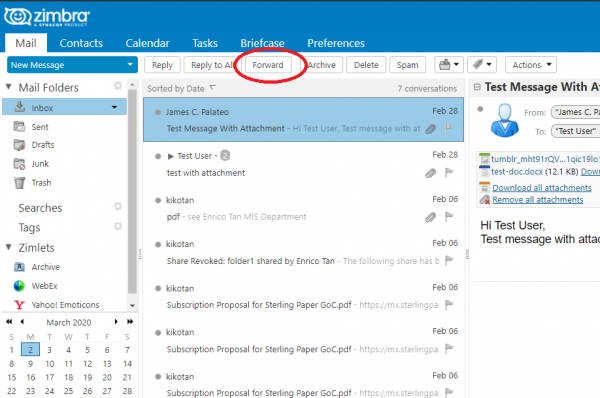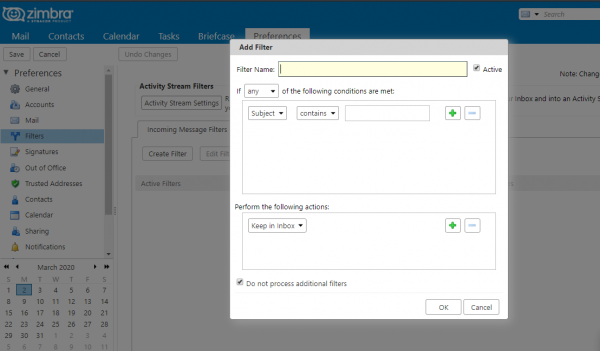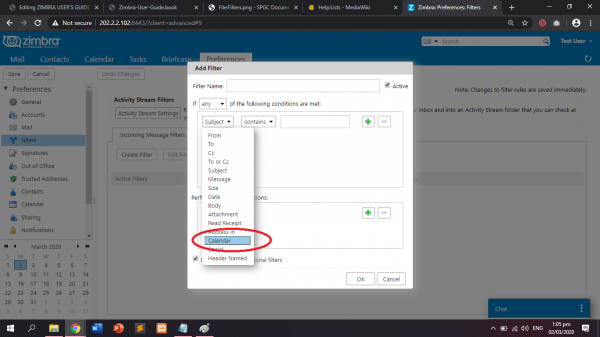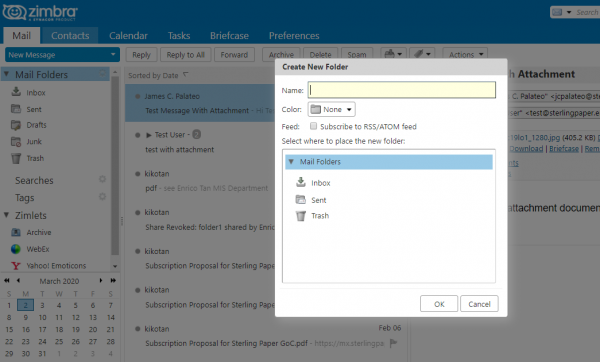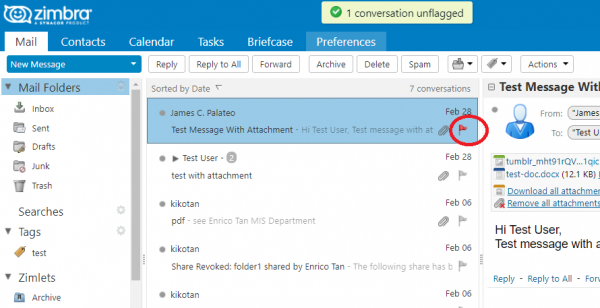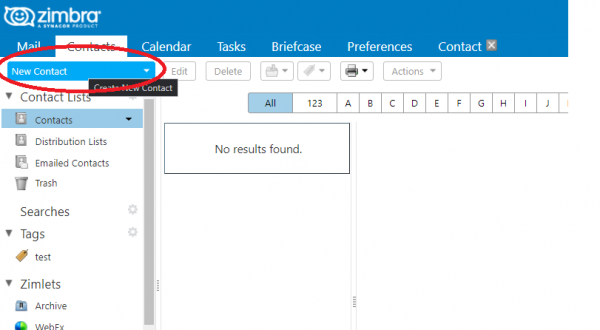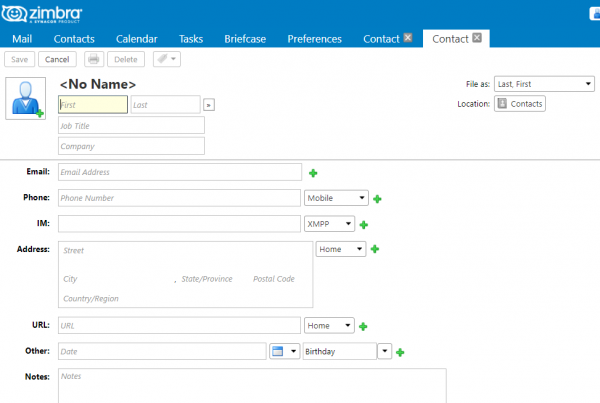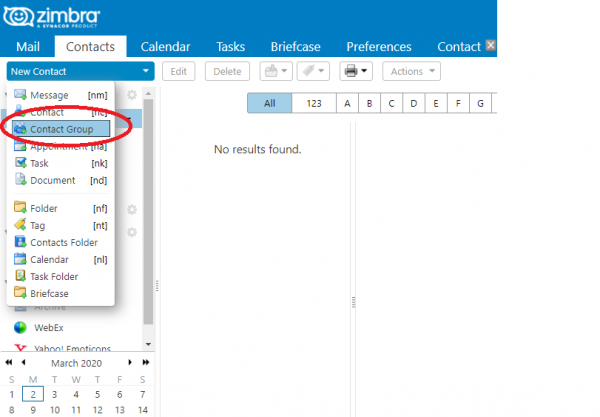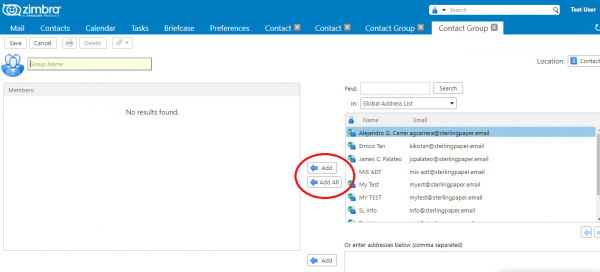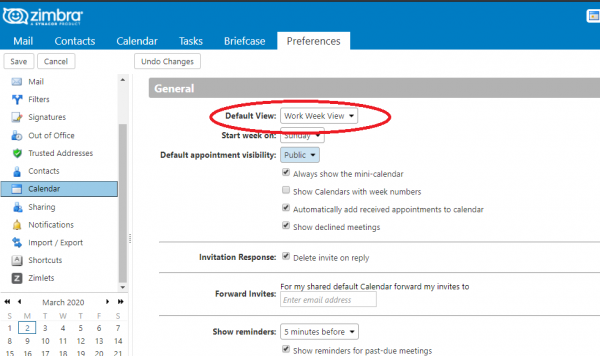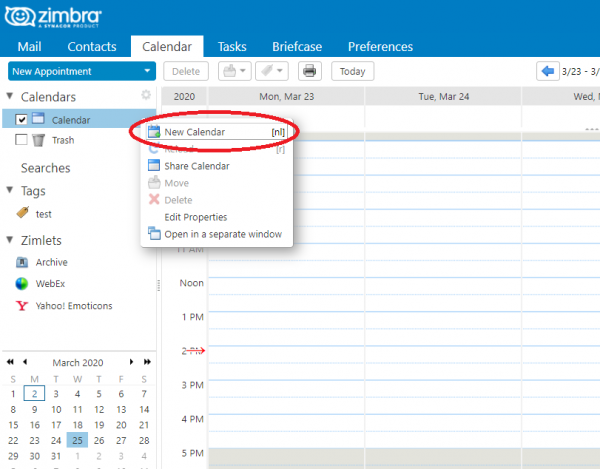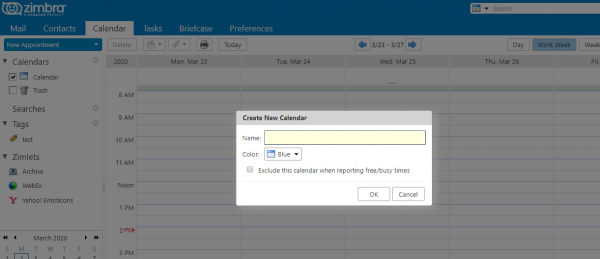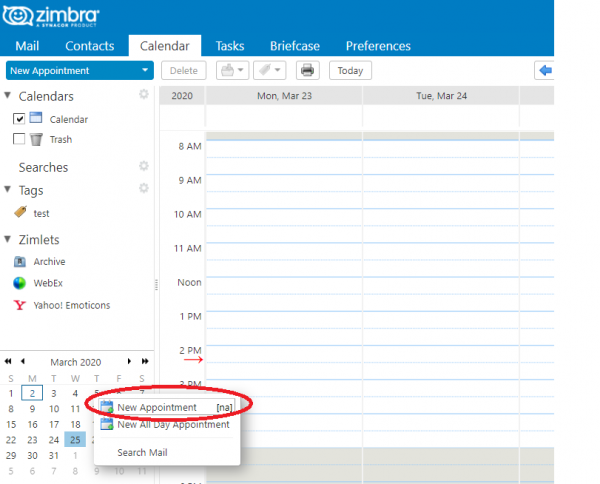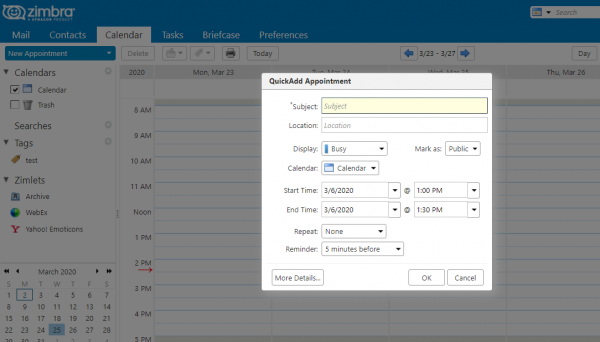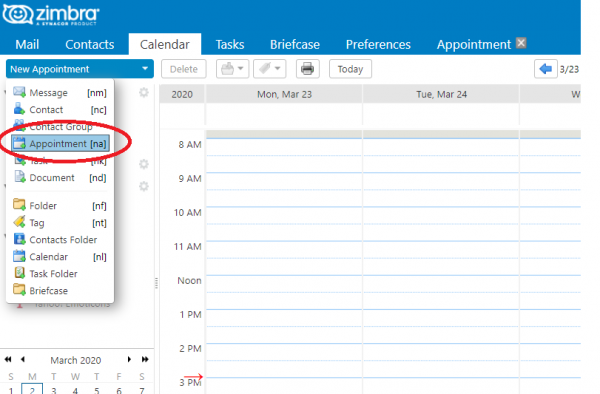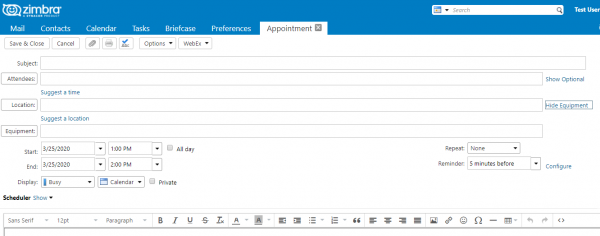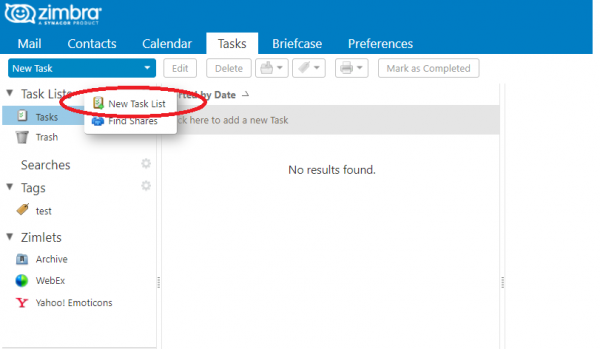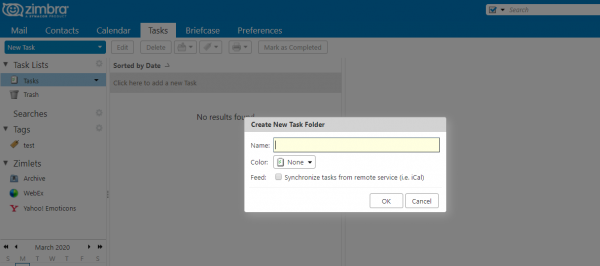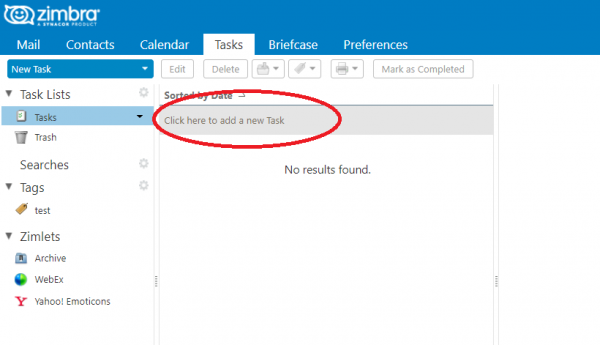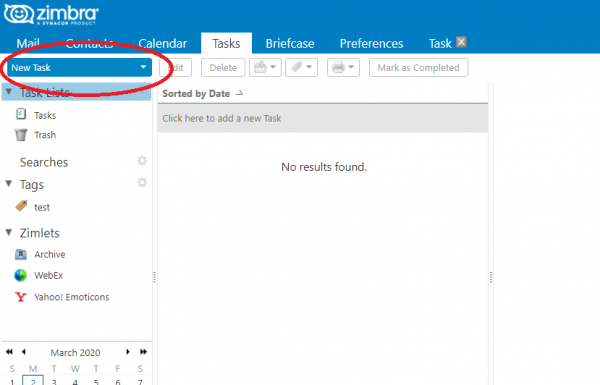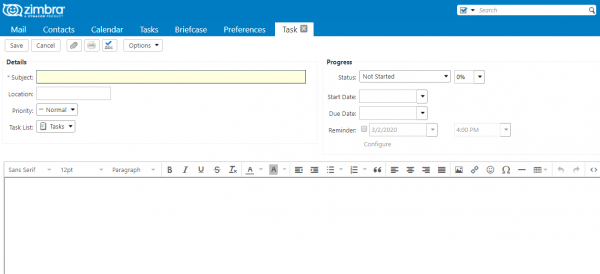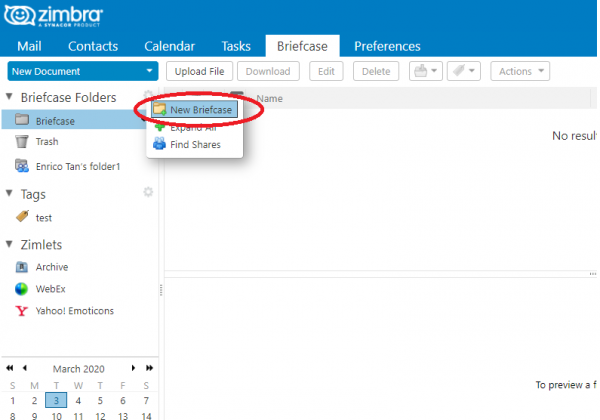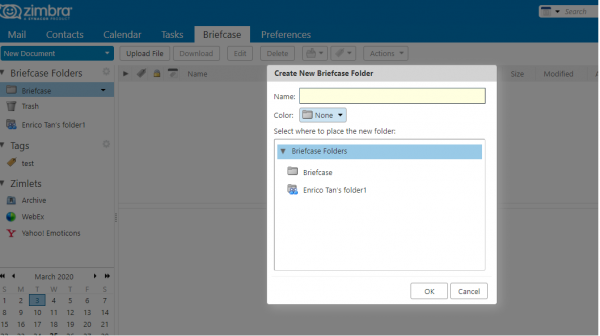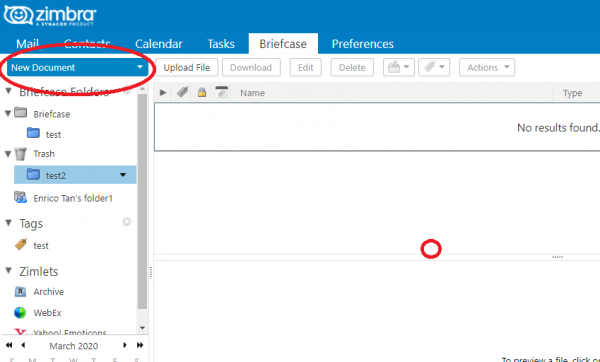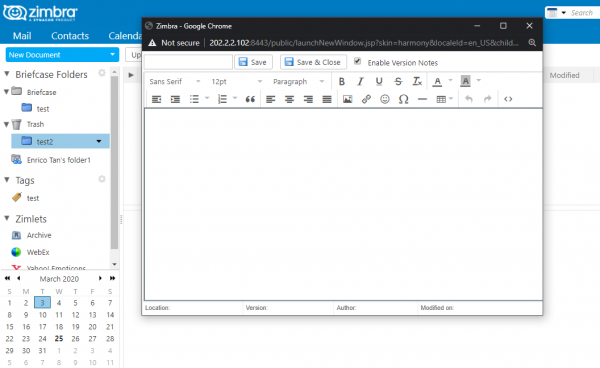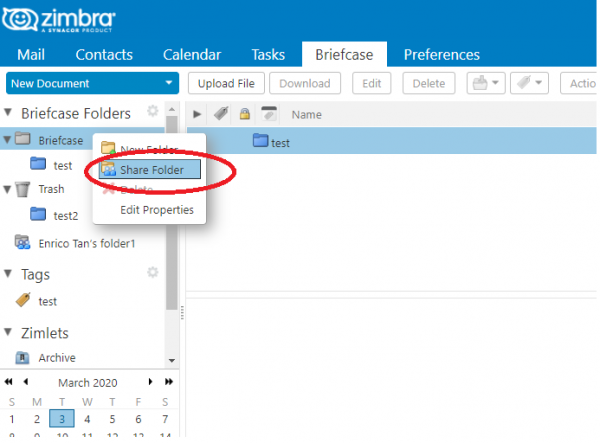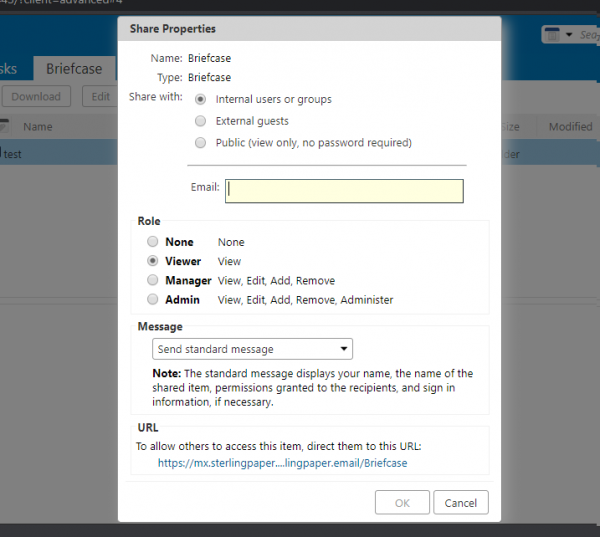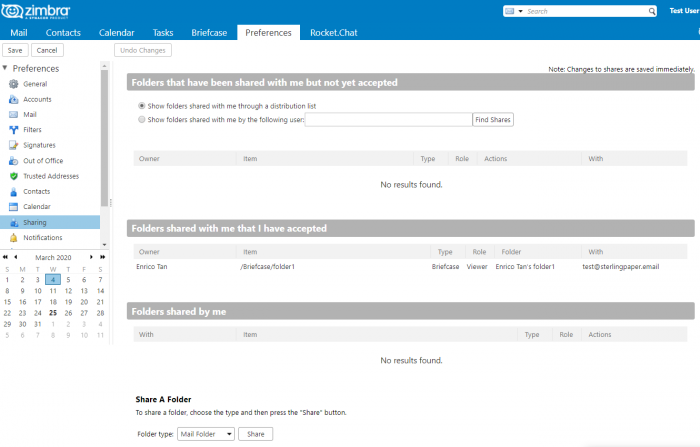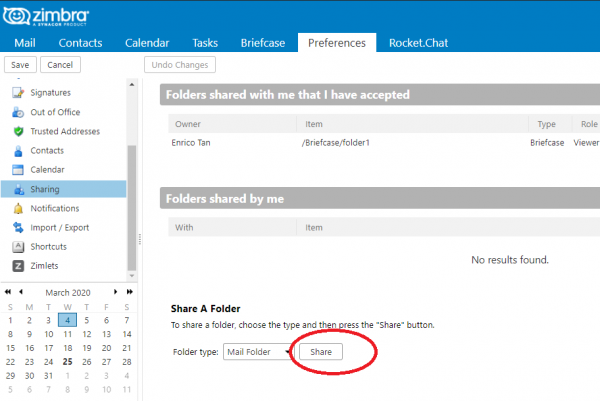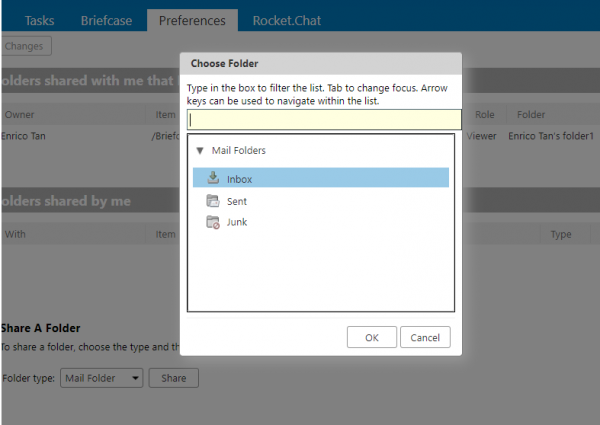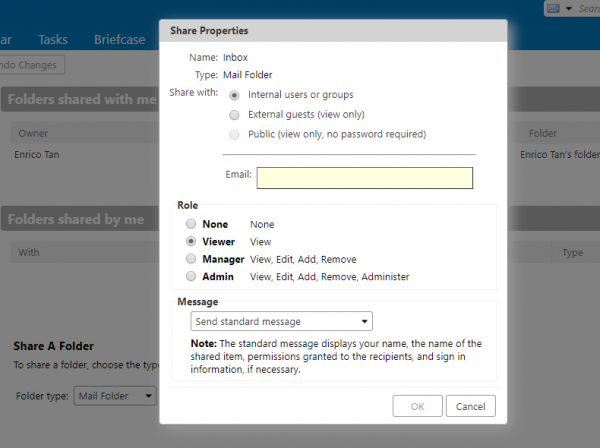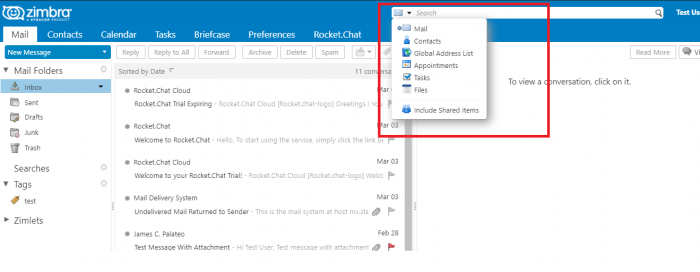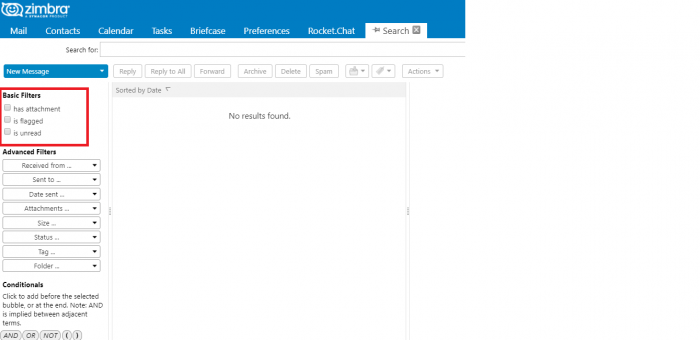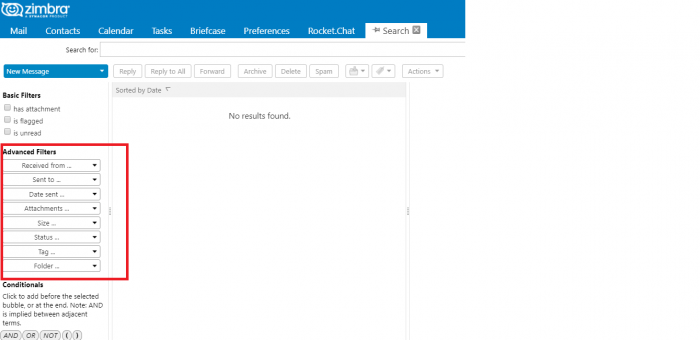Difference between revisions of "ZIMBRA USER'S GUIDE"
(→Searching for Messages Sent To or From the Sender) |
(→Appendix A: Comparing Advanced Zimbra Web Client and Standard Zimbra Web Client) |
||
| (71 intermediate revisions by the same user not shown) | |||
| Line 2,100: | Line 2,100: | ||
=== Searching Your Account === | === Searching Your Account === | ||
| − | ==== | + | ====Finding an Item with Quick Search==== |
::A quick way to search is to type a name or word, without any keywords in the search text box. For example, to find all mail containing the word " ::tim" anywhere in the subject line, To: From: Cc: or Bcc: lines, message body, or file attachment, type tim into the search box and click Search. | ::A quick way to search is to type a name or word, without any keywords in the search text box. For example, to find all mail containing the word " ::tim" anywhere in the subject line, To: From: Cc: or Bcc: lines, message body, or file attachment, type tim into the search box and click Search. | ||
| Line 2,111: | Line 2,111: | ||
::The drop-down arrow on the left of the search text box allows you to select which type of items to search for. | ::The drop-down arrow on the left of the search text box allows you to select which type of items to search for. | ||
| − | ===== | + | =====Perform a Quick Search===== |
:1. In the <b>Search</b> text box, type the search text. For search options, see [[Searching Syntax on page 123]]. <br> | :1. In the <b>Search</b> text box, type the search text. For search options, see [[Searching Syntax on page 123]]. <br> | ||
:2. Select which part of your account to search from the drop-down menu next to the search text box. <br> | :2. Select which part of your account to search from the drop-down menu next to the search text box. <br> | ||
:3. Press <b>Enter</b>.When you are finished with the search, you can clear the search by clicking the <b>X</b> on the search tab. <br> | :3. Press <b>Enter</b>.When you are finished with the search, you can clear the search by clicking the <b>X</b> on the search tab. <br> | ||
| + | |||
| + | |||
| + | [[File:search.png|700px|center]] | ||
| + | |||
<b> Performing an Advanced Search </b> <br> | <b> Performing an Advanced Search </b> <br> | ||
| Line 2,124: | Line 2,128: | ||
:3. You can further refine your search criteria by adding AND, OR, or NOT search conditions. <br> | :3. You can further refine your search criteria by adding AND, OR, or NOT search conditions. <br> | ||
| − | ==== | + | |
| + | [[File:search2.png|700px|center]] | ||
| + | |||
| + | ====Search Filters You Can Use ==== | ||
:When you click the magnifying glass in the search text box, you can select to use basic and advanced filters to build search queries.<br> | :When you click the magnifying glass in the search text box, you can select to use basic and advanced filters to build search queries.<br> | ||
| − | ===== | + | =====Basic Filters===== |
:On the advanced search page, select Basic Filters such as <b>has attachment, is</b> <b>flagged</b> and <b>is unread</b> to perform a general search for messages matching your selected criteria. | :On the advanced search page, select Basic Filters such as <b>has attachment, is</b> <b>flagged</b> and <b>is unread</b> to perform a general search for messages matching your selected criteria. | ||
| − | ===== | + | |
| + | |||
| + | [[File:search6.png|700px|center]] | ||
| + | |||
| + | =====Advanced Filters===== | ||
:To build more complex and detailed search queries, use the advanced filters as described in the table below. | :To build more complex and detailed search queries, use the advanced filters as described in the table below. | ||
| Line 2,161: | Line 2,172: | ||
|} | |} | ||
| − | ==== | + | |
| + | [[File:search5.png|700px|center]] | ||
| + | |||
| + | ====Searching Syntax==== | ||
:You can search for any item, such as a word, first name, last name, phone number, or domain name. When you are searching for content, there are :certain rules to keep in mind. Searching for content searches the body of the message, plus any system-readable file attachments. <br> | :You can search for any item, such as a word, first name, last name, phone number, or domain name. When you are searching for content, there are :certain rules to keep in mind. Searching for content searches the body of the message, plus any system-readable file attachments. <br> | ||
*<b>Exact text match: </b> If you search for phrases, each word within that phrase must be an exact match. Spelling variants are not allowed. For :example, if you search for <b>bananas</b>, messages with <b>banana</b> are not a match. <br> | *<b>Exact text match: </b> If you search for phrases, each word within that phrase must be an exact match. Spelling variants are not allowed. For :example, if you search for <b>bananas</b>, messages with <b>banana</b> are not a match. <br> | ||
| Line 2,172: | Line 2,186: | ||
:<i><u><b>Note:</b> Searching content in the Zimbra Web Client differs slightly from textmatch searches or word-processing features such as Find.</u></i> | :<i><u><b>Note:</b> Searching content in the Zimbra Web Client differs slightly from textmatch searches or word-processing features such as Find.</u></i> | ||
| − | + | ====Searching with Key Words==== | |
| − | ==== | + | |
:If you know where to search for your item, you can enter keywords followed by | :If you know where to search for your item, you can enter keywords followed by | ||
:a colon and search item in the search text box. For example, in:”inbox”. | :a colon and search item in the search text box. For example, in:”inbox”. | ||
| Line 2,238: | Line 2,251: | ||
|} | |} | ||
| − | ==== | + | ====Using * as a Wildcard in Search==== |
:The asterisk * after a prefix can be used as a wildcard in a search to find content with words that have similar spellings. For example, do* returns :items with the word <b>dog, door,</b> etc. | :The asterisk * after a prefix can be used as a wildcard in a search to find content with words that have similar spellings. For example, do* returns :items with the word <b>dog, door,</b> etc. | ||
:<i><u><b>Note:</b> A double-byte asterisk sign in a search query is not considered a wildcard character and is ignored when the search runs.</u></i> | :<i><u><b>Note:</b> A double-byte asterisk sign in a search query is not considered a wildcard character and is ignored when the search runs.</u></i> | ||
| − | ==== | + | ====Setting Search Folders and Items Preferences==== |
:Trash, Spam and Shared folders are by default not included in search settings. You can set your preferences to include these folders and items in :your search. | :Trash, Spam and Shared folders are by default not included in search settings. You can set your preferences to include these folders and items in :your search. | ||
:1. Go to <b>Preferences>General</b> page. | :1. Go to <b>Preferences>General</b> page. | ||
| Line 2,249: | Line 2,262: | ||
:3. Click <b>Save</b>. | :3. Click <b>Save</b>. | ||
| − | ==== | + | ====Displaying Search String==== |
:1. Go to <b>Preferences>General</b> page. <br> | :1. Go to <b>Preferences>General</b> page. <br> | ||
:2. Select <b>Search Language>Show advanced search language in search toolbar </b> to show search string details in the search text box. By default, :this option is not selected. <br> | :2. Select <b>Search Language>Show advanced search language in search toolbar </b> to show search string details in the search text box. By default, :this option is not selected. <br> | ||
:3. Click <b>Save.</b> | :3. Click <b>Save.</b> | ||
| − | ==== | + | ====Saving a Search Query==== |
:If you create a search that you want to use again, you can save it. | :If you create a search that you want to use again, you can save it. | ||
:1. Create the search query. | :1. Create the search query. | ||
| Line 2,262: | Line 2,275: | ||
:5. Click <b>OK.</b> <br> | :5. Click <b>OK.</b> <br> | ||
| − | ==== | + | ====Searching for Messages Sent To or From the Sender==== |
:You can search for messages received from or sent to the sender of a message in one of the following ways: | :You can search for messages received from or sent to the sender of a message in one of the following ways: | ||
::*By right-clicking a message that was sent or received from the sender. | ::*By right-clicking a message that was sent or received from the sender. | ||
::*Using advanced search filters. | ::*Using advanced search filters. | ||
| − | ===== | + | =====Search From Messages that You Received===== |
::<u><i><b>Note:</b> Select a message, not a conversation to perform this search.</i></u> | ::<u><i><b>Note:</b> Select a message, not a conversation to perform this search.</i></u> | ||
::1. In your Inbox or other personal folder, select a message received from the sender you want to find. | ::1. In your Inbox or other personal folder, select a message received from the sender you want to find. | ||
::2. Right-click the message and select Find Emails. | ::2. Right-click the message and select Find Emails. | ||
::3. Select either Received From Sender or Sent to Sender. The search is executed, and messages that meet your request display in the Content pane. | ::3. Select either Received From Sender or Sent to Sender. The search is executed, and messages that meet your request display in the Content pane. | ||
| − | ===== | + | |
| + | =====Use Advanced Search===== | ||
::1. In the search text box, click the <b>magnifying glass.</b> The advanced search page displays. | ::1. In the search text box, click the <b>magnifying glass.</b> The advanced search page displays. | ||
::2. In the Navigation pane, from the advanced filters drop down select <b>Received from...</b> or <b>Sent to ...</b> and enter the sender’s email ::address or domain. The search syntax displays in the search text box at the top of the page. | ::2. In the Navigation pane, from the advanced filters drop down select <b>Received from...</b> or <b>Sent to ...</b> and enter the sender’s email ::address or domain. The search syntax displays in the search text box at the top of the page. | ||
::The search is executed and messages that meet your request display in the Content pane. | ::The search is executed and messages that meet your request display in the Content pane. | ||
| − | ==== | + | |
| + | ====Searching for Messages Sent To or From the Recipient==== | ||
::You can search for messages from or to a recipient of a message in one of the following ways: | ::You can search for messages from or to a recipient of a message in one of the following ways: | ||
::*From the Sent or Drafts folders To column | ::*From the Sent or Drafts folders To column | ||
| Line 2,281: | Line 2,296: | ||
::When you search within a folder, only results for messages within that folder are displayed. When you use the advanced search option, you can select | ::When you search within a folder, only results for messages within that folder are displayed. When you use the advanced search option, you can select | ||
::which folders to search. Results include messages from the folders selected for the search. | ::which folders to search. Results include messages from the folders selected for the search. | ||
| − | ===== | + | =====Search Sent and Draft Folders===== |
::<u><i><b>Note:</b> Select a message, not a conversation to perform this search.</i></u> | ::<u><i><b>Note:</b> Select a message, not a conversation to perform this search.</i></u> | ||
::1. In the <b>Sent</b> and <b>Drafts</b> folders, select a message with the name of the recipient you want to find. | ::1. In the <b>Sent</b> and <b>Drafts</b> folders, select a message with the name of the recipient you want to find. | ||
| Line 2,287: | Line 2,302: | ||
::3. Select either Received From Recipients or Sent To Recipients. The search is executed and messages that meet your request display in the Content | ::3. Select either Received From Recipients or Sent To Recipients. The search is executed and messages that meet your request display in the Content | ||
::pane. | ::pane. | ||
| − | ===== | + | |
| + | =====Use Advanced Search===== | ||
::1. In the search text box, click the <b>magnifying glass.</b> The advanced search page displays. | ::1. In the search text box, click the <b>magnifying glass.</b> The advanced search page displays. | ||
::2. In the Navigation pane, select from the advanced filters drop down select <b>Received from...</b> or <b>Sent to ...</b> and enter the recipient’s ::email address or domain. The search syntax displays in the Search field at the top of the page. | ::2. In the Navigation pane, select from the advanced filters drop down select <b>Received from...</b> or <b>Sent to ...</b> and enter the recipient’s ::email address or domain. The search syntax displays in the Search field at the top of the page. | ||
::The search is executed and messages that meet your request display in the Content pane. | ::The search is executed and messages that meet your request display in the Content pane. | ||
| − | ==== | + | |
| + | ====Search Examples==== | ||
:When performing an advanced search, you use different panes depending on the search criteria. The following examples demonstrate which search panes | :When performing an advanced search, you use different panes depending on the search criteria. The following examples demonstrate which search panes | ||
:to use for particular types of searches. | :to use for particular types of searches. | ||
| − | ===== | + | =====Search for a specific type of attachment===== |
:You are looking for a message with a picture attached. You don't remember who sent it or when, but you recall that it was either a PDF or JPEG file. | :You are looking for a message with a picture attached. You don't remember who sent it or when, but you recall that it was either a PDF or JPEG file. | ||
:How to do it: | :How to do it: | ||
| Line 2,302: | Line 2,319: | ||
:4. Click <b>Search.</b> <br> | :4. Click <b>Search.</b> <br> | ||
| − | ===== | + | =====Search for a contact from a specific company===== |
:You don't remember the contact's name but you know the name of the company that the person works for. | :You don't remember the contact's name but you know the name of the company that the person works for. | ||
:How to do it: | :How to do it: | ||
| Line 2,309: | Line 2,326: | ||
:3. Click <b>Search.</b> <br> | :3. Click <b>Search.</b> <br> | ||
| − | ===== | + | =====Search for an item that was tagged===== |
:You want to find all the new procedures for your industry, which you had tagged as Industry News. | :You want to find all the new procedures for your industry, which you had tagged as Industry News. | ||
:How to do it: | :How to do it: | ||
| Line 2,315: | Line 2,332: | ||
:2. Click the tag Industry News. Items that are tagged with the <b>Industry</b> news tag display. Note: Tags are user-defined, so this assumes that you have already created the tag and applied it to objects in your mailbox. | :2. Click the tag Industry News. Items that are tagged with the <b>Industry</b> news tag display. Note: Tags are user-defined, so this assumes that you have already created the tag and applied it to objects in your mailbox. | ||
| − | ===== | + | =====Search by a date range<===== |
:Someone who sends you a lot of email claims to have sent you a specific message in early February. Rather than look through all your emails, you can | :Someone who sends you a lot of email claims to have sent you a specific message in early February. Rather than look through all your emails, you can | ||
:search by the contact name and the date range. | :search by the contact name and the date range. | ||
| Line 2,325: | Line 2,342: | ||
:5. Select <b>is after</b> and specify a start date. | :5. Select <b>is after</b> and specify a start date. | ||
:6. Click <b>Search.</b> | :6. Click <b>Search.</b> | ||
| − | ===== | + | |
| + | =====Search for mail across all folders===== | ||
:For example, you are looking for email from your manager. You know your manager’s email address, but don’t remember what folder you have placed | :For example, you are looking for email from your manager. You know your manager’s email address, but don’t remember what folder you have placed | ||
:email received from him in. | :email received from him in. | ||
| Line 2,335: | Line 2,353: | ||
:5. Click <b>Search</b> | :5. Click <b>Search</b> | ||
| − | ==== | + | ====Understanding Advanced Search Query Language ==== |
:This advanced topic describes in detail the search grammar used for ZWC Search feature. | :This advanced topic describes in detail the search grammar used for ZWC Search feature. | ||
| − | ===== | + | =====Search Language Structure===== |
:Simple searches can be performed by entering a word into the search text box. Bare words (words without a search operator) are interpreted to search :in the 'content:' operator -- this matches any text in the message. | :Simple searches can be performed by entering a word into the search text box. Bare words (words without a search operator) are interpreted to search :in the 'content:' operator -- this matches any text in the message. | ||
More advanced searches can be done by specifying a search operator. A <b>search operator</b> is a special keyword followed by a colon, followed by some other parameter specific to that operator. For example: | More advanced searches can be done by specifying a search operator. A <b>search operator</b> is a special keyword followed by a colon, followed by some other parameter specific to that operator. For example: | ||
| Line 2,354: | Line 2,372: | ||
:<u><i><b>Note:</b> Special characters, such as trademark symbols that are part of a word, are removed when the word is indexed for search. They are :ignored in a search. For example, a search for Zimbra™ finds all references to Zimbra, including those without the trademark symbol. </i></u> | :<u><i><b>Note:</b> Special characters, such as trademark symbols that are part of a word, are removed when the word is indexed for search. They are :ignored in a search. For example, a search for Zimbra™ finds all references to Zimbra, including those without the trademark symbol. </i></u> | ||
| − | ===== | + | =====Multiple Search Terms===== |
:If multiple search terms are entered (separated by spaces), they are " ANDed" together by default. <b>in:inbox</b> tim means "return me messages :which are in the inbox AND which have the word tim in them". For searches using multiple criteria, you can either find items that match one of the :specified criteria or all of them. | :If multiple search terms are entered (separated by spaces), they are " ANDed" together by default. <b>in:inbox</b> tim means "return me messages :which are in the inbox AND which have the word tim in them". For searches using multiple criteria, you can either find items that match one of the :specified criteria or all of them. | ||
| Line 2,367: | Line 2,385: | ||
:<b>Tip:</b> Using parenthesis with AND and OR. Words within parentheses are considered as a unit. For example <b>from: (john thomas)</b> is equivalent to <b>from:john AND from: thomas.</b> If you use OR in the parenthesis, <b>from:(john or smith),</b> the search is for results <b>from:john OR from: smith.</b> | :<b>Tip:</b> Using parenthesis with AND and OR. Words within parentheses are considered as a unit. For example <b>from: (john thomas)</b> is equivalent to <b>from:john AND from: thomas.</b> If you use OR in the parenthesis, <b>from:(john or smith),</b> the search is for results <b>from:john OR from: smith.</b> | ||
| + | |||
| + | === Sending and Receiving Secure Email === | ||
| + | |||
| + | :<u><i><b>Note:</b> This feature is for Zimbra Collaboration Network Edition only and is available only in the Advanced Web Client.</i></u> | ||
| + | |||
| + | If the S/MIME feature is enabled for your account, you can set up S/MIME to send and receive digitally signed and encrypted messages. | ||
| + | |||
| + | To use S/MIME with the Zimbra Collaboration, you must have a secure email signing certificate suitable for S/MIME signing and encryption. The certificate with private key must be installed in the local certificate store on a Windows computer, Mac OSX computer, or in the browser certificate store if using Firefox. For information about how to install your certificate see the appropriate computer or browser documentation. | ||
| + | |||
| + | To send and receive encrypted and signed messages, your public key and recipient's public key must be exchanged. To get a copy of a recipient's public | ||
| + | key, you can send a digitally signed message using your certificate to the recipient and request that they send you a digitally signed message in reply. | ||
| + | When the message is received, the recipient's certificate is stored in the recipient's contact page in Contacts, or a contact is automatically created. | ||
| + | Note the following differences when working with encrypted messages: | ||
| + | |||
| + | :*If you are sharing your Inbox, delegated users cannot read your encrypted messages from their computers. Your private key is required to read | ||
| + | :encrypted messages. | ||
| + | :*You cannot run spell check on an encrypted message. | ||
| + | :*You cannot search for text in the body or attachments of an encrypted message. Only the header information such as sent to or from, date message was :sent, or subject can be found in a search. | ||
| + | |||
| + | ====Setting Security Preferences for Using S/MIME==== | ||
| + | |||
| + | :If the S/MIME feature is enabled for your account, a Security page is available in your Preferences. | ||
| + | |||
| + | :The default setting for the Security preference is to automatically remember the last security option you selected when you composed an email. | ||
| + | |||
| + | :You can change the default preference to always send your messages as signed, as signed and encrypted, or to not sign or encrypt your messages. You | ||
| + | :can change the option from the Security tab in the compose page, but the change is only for that message. | ||
| + | |||
| + | :1. Click <b>Preferences.</b> | ||
| + | :2. In the Overview pane, click <b>Security.</b> | ||
| + | :3. Change the settings. | ||
| + | ::*<b>Auto (remember last settings)</b> is the default. The last security option you select is remembered. | ||
| + | ::*Select <b>Do not sign or encrypt</b> if you do not use the S/MIME feature at all or rarely. | ||
| + | ::*Select <b>Sign only</b> if you always send your email with a digital signature. | ||
| + | ::*Select <b>Sign and encrypt</b> if you always send your email encrypted with a digital signature. | ||
| + | :4. Click <b>Save.</b> | ||
| + | |||
| + | ====Composing and Sending a Digitally Signed Message==== | ||
| + | :Digitally signed messages can be sent to any recipient. A signed-only option does not require a recipient’s key, only the sender's certificate and public key. | ||
| + | :1. Click <b>New</b> on the toolbar. | ||
| + | :2. In <b>To</b>: enter the user's address or click the <b>To</b>: link to search for an address from your address books. | ||
| + | :3. If your security preference is not set by default to send digitally signed messages, click <b>Security</b> and select <b>Sign only.</b> | ||
| + | :4. Enter a subject of the message. | ||
| + | :5. Compose the message. | ||
| + | :6. To add an attachment, click <b>Add Attachment</b> and browse to the file, or drag and drop the file from your computer to the email header. | ||
| + | :7. Click <b>Send.</b> | ||
| + | |||
| + | ====Composing and Sending an Encrypted Message==== | ||
| + | :Messages can be sent encrypted to recipients that have sent you their public key and certificate. The recipient’s certificate is stored in the :recipients contact page in Address Book. | ||
| + | :1. Click <b>New</b> on the toolbar. | ||
| + | :2. If your security preference is not set by default to send encrypted and digitally signed messages Click <b>Security</b> and select <b>Sign and Encrypt.</b> | ||
| + | :3. In <b>To</b>: enter the user's address or click the To: link to search for an address from your address books. | ||
| + | :4. Enter a subject of the message. | ||
| + | :5. Compose the message. | ||
| + | :6. To add an attachment, click <b>Add Attachment</b> and browse to the file, or drag and drop the file from your computer to the email header section. | ||
| + | :7. Click <b>Send</b>. | ||
| + | :You cannot run spell check on an encrypted message. | ||
| + | |||
| + | ====Adding Certificates to Contacts in Your Address Book==== | ||
| + | :The contact page in the Address Book includes a Certificate field. When a message with a certificate is received from someone listed in your address | ||
| + | :books, the certificate is stored in the recipients contact page in the address book. | ||
| + | |||
| + | :If a signed message is received from a recipient who is not an existing contact in your address book, a new contact is automatically created in the :Contacts folder and the certificate is stored with the newly generated contact. | ||
| + | |||
| + | :You can also upload the recipient’s certificate if it is sent as an attachment. | ||
=== Using Chat and Voice Services === | === Using Chat and Voice Services === | ||
| Line 2,377: | Line 2,460: | ||
#The launch application displays. Select the application to initiate a chat session and click OK. | #The launch application displays. Select the application to initiate a chat session and click OK. | ||
: Depending on the presence status of the contact, your chat session begins. | : Depending on the presence status of the contact, your chat session begins. | ||
| + | |||
| + | === Using the Offline Mode === | ||
| + | |||
| + | :Zimbra Offline Mode allows you to use the Zimbra Web Client (ZWC) and access your data without network connectivity. | ||
| + | |||
| + | :For example, if there is no server connectivity or server connectivity is lost, ZWC automatically transitions to “offline mode”. When server :connectivity is restored, ZWC automatically reverts back to “online mode”. | ||
| + | |||
| + | :The offline mode uses HTML5, which uses a caching capability that can be considered a super set of the normal browser caching. This feature is enabled | ||
| + | :by your system administrator. | ||
| + | |||
| + | ====Offline Mode Features and Functionality==== | ||
| + | :Offline mode features and functionality include: | ||
| + | :*No browser plug-ins or extensions are required. | ||
| + | :*Uses the same mail URL (for example, https://example.domain.com), which you can browse to even when there is no connection to the server. | ||
| + | :*When in online mode and connected to the server, a spinning icon displays in the top right of the screen indicating your data is automatically being | ||
| + | :synchronized to the server. | ||
| + | :*When in offline mode, a disconnected icon displays in the top right of the screen. Any work performed in offline mode is stored in cache, and | ||
| + | :synchronized with the server when reverted back to online mode. | ||
| + | :*Mail, Contacts, Calendar, and Search applications are supported in offline mode. Tabs such as Community, Tasks, Briefcase and Preferences are not | ||
| + | :available and are disabled from your view. Other features that are not available include shared folders and Zimlets. | ||
| + | :*Signing out of ZWC turns off the offline mode setting, and will delete any offline data. If you attempt to sign out, a warning displays informing you :of this issue. | ||
| + | |||
| + | ====Supported Browsers==== | ||
| + | :Browsers supported for offline mode include: | ||
| + | :*Google Chrome | ||
| + | :*Mozilla Firefox | ||
| + | |||
| + | ====Enabling or Disabling Offline Mode==== | ||
| + | When offline mode is enabled, whenever your machine loses connectivity to the server the ZWC client will automatically switch to offline mode. | ||
| + | |||
| + | If you use another browser or device to access your ZWC account, other than the one in which you enabled offline mode, you must enable offline mode | ||
| + | again. | ||
| + | |||
| + | If you do not want to allow offline mode, you can select to disable the feature. | ||
| + | |||
| + | =====Enable Offline Mode===== | ||
| + | :1. In the ZWC, click the dropdown menu next to your name in the upper right of the screen. | ||
| + | :2. Select <b>Offline Mode.</b> | ||
| + | :3. In the <b>Offline Mode</b> dialog, select <b>Allow offline mode</b> and click <b>OK.</b> | ||
| + | :4. Accept the warning that displays asking if you want to reload the application now to enable offline access? Click <b>Yes.</b> | ||
| + | :5. The application reloads and a sync icon displays in the upper right of the screen. You are now working in offline mode. | ||
| + | |||
| + | :<u><i><b>Note:</b> If you don’t reload the application, offline access is available the next time you sign in.</i></u> | ||
| + | |||
| + | =====Disable Offline Mode===== | ||
| + | :You can disable offline mode so that when server connectivity is lost the ZWC will not go into offline mode. This will also result in locally cached :data in the browser being erased. | ||
| + | |||
| + | :To disable offline mode: | ||
| + | |||
| + | :1. In the ZWC, click the dropdown menu next to your name in the upper right of the screen. | ||
| + | :2. Select <b>Offline Mode.</b> | ||
| + | :3. In the <b>Offline Mode</b> dialog, select <b>Don’t allow offline mode</b> Your ZWC will not go into offline mode when server connectivity is lost. | ||
| + | |||
| + | ====Using Mail in Offline Mode==== | ||
| + | :When using your mail in offline mode, you can view your messages, compose new messages, and select how long to store your offline content. | ||
| + | |||
| + | =====Viewing Your Messages Offline Mode===== | ||
| + | :Only message view is supported in offline mode. Conversation view is not supported. When ZWC switches to offline mode, your message view :automatically switches to message view only. When ZWC automatically switches back to online mode, your messages automatically switch back to :conversation mode or your original preference. | ||
| + | |||
| + | :You can view your messages offline, and perform actions such as mark as unread, flag or tag, move, or delete. You can also view attachments. | ||
| + | |||
| + | =====Composing a New Message in Offline Mode===== | ||
| + | :You can compose a new message in offline mode, including replying to messages, forwarding messages, and creating and editing Drafts. You can | ||
| + | :also attach items to your messages, selecting from documents that are available on your local machine. | ||
| + | |||
| + | :When addressing a new message in offline mode, the address auto-complete is available using email addresses stored in your local Contacts. The Global | ||
| + | :Address List (GAL) is not available. | ||
| + | |||
| + | :If you receive a Calendar invitation, you can accept, decline, or reply as tentative to the invitation. The reply is then sent when your machine is :reverted to online mode and resynchronized to the server. | ||
| + | |||
| + | =====Selecting How Long to Store Offline Content===== | ||
| + | :By default, if your machine is in offline mode, the last 30 days of your Inbox, Sent, Drafts, and Trash messages are stored in cached. They are then | ||
| + | :synchronized to the server when your machine reverts to online mode. This setting is configurable. | ||
| + | |||
| + | :You can select the folders you want to use for offline access, and the number of days you want your messages to stay in cache. If you do not want :your | ||
| + | :messages to synchronize when reverted back to online mode, select 0. | ||
| + | |||
| + | :To configure offline storage: | ||
| + | |||
| + | :1. Right click a folder for which you want to configure offline storage. | ||
| + | :2. Select <b>Edit Properties</b> | ||
| + | :3. Select the number of days to store messages. | ||
| + | :4. Click <b>OK.</b> | ||
| + | |||
| + | ====Using Contacts in Offline Mode==== | ||
| + | :When using your Contact Lists in offline mode, all email addresses in your local Contacts are supported and available for use. Other Contact Lists, | ||
| + | :including Global Address List and Distribution Lists, are view only. | ||
| + | |||
| + | ====Using Calendar in Offline Mode==== | ||
| + | :When using your Calendar in offline mode, you can perform actions such as viewing, creating new events, accepting invitations, or viewing reminders. | ||
| + | :When your ZWC goes back online, calendar items that are cached in offline mode are synchronized with your online calendar. | ||
| + | |||
| + | =====Viewing Calendars in Offline Mode===== | ||
| + | :You can view your calendar by Month/Week/Work week/Day views, including viewing details of an appointment. If you have more than one calendar, you | ||
| + | :can select the calendar or calendars to view. Viewing calendars is available in read-only mode when offline. | ||
| + | |||
| + | =====Creating a New Calendar Event in Offline Mode===== | ||
| + | :Calendar actions such as creating, editing, or deleting are not available, as the Calendar is view only in offline mode. | ||
| + | |||
| + | =====Accepting a Calendar Event in Offline Mode===== | ||
| + | :You can accept, decline, or mark an invitation as tentative. The reply to the event is cached and sent when your ZWC is in online mode. | ||
| + | |||
| + | =====Viewing Reminders in Offline Mode===== | ||
| + | :Reminders are supported in offline mode, and you can dismiss or snooze an event. | ||
| + | |||
| + | =====Synchronizing Calendars when Reverting to Online Mode===== | ||
| + | :All local appointments, starting with the last week up to the next three weeks are synchronized with your Calendar when you revert from offline mode :to online mode. | ||
| + | |||
| + | :When synchronizing, your Calendar updates older appointments that are in the offline cache, with new appointments created within the default three :week period. Mini-calendars are also populated with cached data when reverting from offline mode to online mode. | ||
| + | |||
| + | ====Using Search in Offline Mode==== | ||
| + | :You can use the Search feature in offline mode to search your Mail or Contacts. | ||
| + | |||
| + | :The following search filters and options are supported: | ||
| + | |||
| + | :* subject | ||
| + | :* from, to, cc, tocc | ||
| + | :* tag | ||
| + | :* folder | ||
| + | :* size | ||
| + | :* status read/unread/flagged/unflagged | ||
| + | :* date sent on/before/after | ||
| + | :* has:attachment | ||
| + | :* attachment type (only in query syntax, not from the user interface) | ||
| + | * Conditional search options (and, or, not). For example, in:contacts and tag:one. | ||
| + | * Saved searches. | ||
| + | * Contact search based on first name, last name, middle name, email address, company name and job title. | ||
| + | |||
| + | ===Using the Touch Client=== | ||
| + | |||
| + | The Zimbra Touch Client application is used on touch-capable mobile devices. | ||
| + | Its features are a subset of the features found in the Zimbra Web Client, including Mail, Contacts, and Calendar. | ||
| + | |||
| + | :<u><i><b>Note</b>: See the Zimbra Collaboration documentation page, at http://www.zimbra.com/support/documentation/zwc-documentation.html, for :the latest information or revision of this chapter.</i></u> | ||
| + | |||
| + | ====Supported Devices==== | ||
| + | :Supported devices for the Zimbra Touch Client include: | ||
| + | :*iOS6+: iPad®, iPad mini®, iPhone®, iPod touch®, Android 4.0+: Nexus 7, Nexus 10, Samsung Galaxy Tab™, Samsung Galaxy S® III, Samsung Galaxy S® 4, :Galaxy Nexus™ | ||
| + | |||
| + | ====Logging In==== | ||
| + | :1. To access the touch client, enter the URL for the Zimbra Web Client and the touch client is automatically detected. For example <b>https://mail.example.com</b> | ||
| + | :2. Enter your <b>Username</b> and <b>Password</b>, and tap <b>Sign In</b>. | ||
| + | |||
| + | =====Signing Out===== | ||
| + | :You can sign out of the touch client using the menu in the tool bar. Tap <b>Sign Out</b>. Once you are signed out, you are redirected to the log-in :screen. | ||
| + | |||
| + | ====General Functionality==== | ||
| + | General functionality of the touch client includes the different layouts you will see when using a tablet or mobile device, switching applications (such as going from Mail to Contacts), and using search. | ||
| + | |||
| + | =====Layouts of the Touch Client===== | ||
| + | :When viewing items within Mail or Contacts, there is a list panel and a reading pane. Calendar uses a single panel to show a day or a month. The :layout you see when using Mail or Contacts depends on the device and its orientation. | ||
| + | |||
| + | :<b>Using a Tablet</b> | ||
| + | |||
| + | :*<b>Landscape View:</b> A tablet in landscape orientation displays both panels, with the list panel on the left and reading pane on the right. The :list panel remains visible while you are viewing a conversation or a contact. | ||
| + | |||
| + | :*<b>Portrait View:</b> When a tablet is in portrait orientation, the list panel is superimposed over the reading pane, and slides back when an item :is viewed. Tapping the <b><Inbox</b> button on the toolbar brings the list back into view. | ||
| + | |||
| + | :<b>Using a Mobile Phone</b> | ||
| + | :A mobile phone only displays one panel regardless of its orientation. When an item is viewed, its panel fills the display. Tapping the <b><Inbox</b> :button on the toolbar brings the list back into view. | ||
| + | |||
| + | =====Using Search===== | ||
| + | :To search your Inbox: | ||
| + | :1. Enter the search criteria in the <b>Search</b> field. | ||
| + | :2. Tap <b>return.</b> | ||
| + | :Your search results display in the list panel. | ||
| + | |||
| + | ====Using Mail==== | ||
| + | :When using Mail, you can view a list of conversations, read a conversation, compose a new message, reply to or forward a message, and perform various | ||
| + | :actions on either conversations or messages such as moving or tagging them. | ||
| + | |||
| + | =====Reading Mail===== | ||
| + | :Your Inbox displays conversations in the list panel. To read your mail, tap the conversation you want to read and it displays in the reading pane. | ||
| + | |||
| + | =====Using the Conversation List===== | ||
| + | :Mail is displayed as a list of conversations. Features of the list include: | ||
| + | :*Icons on the left that indicate whether a conversation is read or unread, lagged, or has an attachment. | ||
| + | :*A number indicating how many messages are in the conversation (if there is more than one, and not including messages in Trash or Junk). | ||
| + | :*Scrolling the list up will load more conversations. | ||
| + | :*The list can be pulled down to refresh it. | ||
| + | |||
| + | =====Viewing a Conversation===== | ||
| + | A conversation is displayed as a list of messages in the list pane. The toolbar on top has buttons that allow you to reply to or forward the conversation, move it to Trash, or perform other actions such as tagging it, flagging it, moving it, or marking it read. | ||
| + | * Each message is shown as collapsed (just the header) or expanded (header and body). Tapping the header toggles between the two. | ||
| + | * Tapping the <b>page corner</b> button in the lower right corner of a message reveals a toolbar that can be used to perform actions on just that :message. | ||
| + | * Tap <b>details</b> on an expanded message to show more of the message header, such as who is copied on the message. | ||
| + | * By default, quoted content is hidden. Tap <b>show quoted text</b> to display quoted content from previous messages in the conversation. | ||
| + | * If a message is tagged, the tag is shown in the expanded view of the message. Tap the tag to display a menu that you can use to remove the tag | ||
| + | :from the message. | ||
| + | * If a message has an attachment, it is shown in the expanded view of the message. Tap an attachment to view. | ||
| + | * At the bottom of the panel there is an input you can use to quickly reply to the conversation. Just type into the box and tap <b>Send</b> to reply to :all participants in the conversation. | ||
| + | |||
| + | =====Composing a New Message===== | ||
| + | :To compose a new message: | ||
| + | :1. Tap the <b>compose</b> button and the Compose dialog displays. | ||
| + | :2. In the <b>To</b> field, enter the recipient’s email address. The address autocomplete feature displays a list of suggested email addresses. | ||
| + | :3. In the <b>Subject</b> field, enter a brief description of the email message. | ||
| + | :4. Compose your email message. | ||
| + | :5. If you want to add an attachment, tap the <b>attachment</b> button and select your attachment. | ||
| + | :6. Tap <b>Send</b>. | ||
| + | |||
| + | =====Replying to or Forwarding a Conversation===== | ||
| + | :You can reply to and forward conversations or messages from a menu or by using the quick reply field. | ||
| + | |||
| + | :*<b>Using the Reply button:</b> Select the conversation you want to read. When the conversation displays, tap the <b>reply</b> button. You can reply, :reply to all, or forward the conversation. The latest message in the conversation is used as the original message you are replying to or forwarding. | ||
| + | :*<b> Using the Quick Reply field:</b> To quickly reply to all, enter your message in the reply field at the bottom of the conversation and tap | ||
| + | ::<b>Send</b>. | ||
| + | |||
| + | =====Replying to or Forwarding an Individual Message===== | ||
| + | :1. To reply to or forward an individual message, tap the <b>page corner</b> button at the lower right of the message. | ||
| + | :2. Tap the <b>reply</b> button. | ||
| + | :3. Select to reply, reply to all, or forward the message. | ||
| + | |||
| + | =====Moving a Conversation or Item to Trash===== | ||
| + | :You can move a conversation or an individual message to trash. Select the item you want place into trash, and tap the <b>Trash</b> button. | ||
| + | |||
| + | =====Marking a Message as Spam===== | ||
| + | :You can mark an individual message as spam by first tapping on the <b>page corner</b> button, then the <b>menu</b> button and selecting <b>Spam</b>. :The message is moved into your Junk folder. | ||
| + | |||
| + | =====Using Folders, Searches, and Tags===== | ||
| + | :Folders, searches, and tags are shown in the overview pane that slides in from the left. | ||
| + | :To display the overview pane, tap the <b>menu</b> button. Your Folders display at the top of the overview pane, and you can scroll down to see Saved :Searches and Tags. | ||
| + | |||
| + | =====Navigating Folders, Searches, and Tags===== | ||
| + | *To view the contents of a folder, tap the folder. | ||
| + | :*A folder with sub-folders displays an expansion arrow on the right of the folder name. Tap the arrow to display the list of sub-folders. | ||
| + | * To view the results of a search, tap the search. | ||
| + | * To view conversations with a particular tag, tap the tag. | ||
| + | |||
| + | =====Adding a New Folder===== | ||
| + | :1. From the overview, tap <b>Edit</b>. | ||
| + | :2. At the bottom of the overview, select <b>New Folder</b>. | ||
| + | :3. Enter the Folder name and Location. | ||
| + | :4. To select a location, tap the Location field and select the location where you want to place the new folder. | ||
| + | :5. Tap <b>Save</b>. | ||
| + | |||
| + | :<b>Adding a New Tag</b> | ||
| + | :1. From the overview, tap <b>Edit</b>. | ||
| + | :2. At the bottom of the overview, select <b>New Tag</b>. | ||
| + | :3. Enter the <b>Tag name</b> and select a color for the tag. | ||
| + | :4. Tap <b>Save</b>. | ||
| + | |||
| + | =====Editing Folders and Tags===== | ||
| + | :1. From the overview, tap <b>Edit</b>. | ||
| + | :2. Tap the folder or tag you want to edit. | ||
| + | :* When editing a folder, you can change the name or parent folder, or move to it trash. | ||
| + | :* When editing a tag, you can change the name or color, or delete the tag. | ||
| + | :4. Tap <b>Save</b>. | ||
| + | |||
| + | ====Using Contacts==== | ||
| + | |||
| + | :You can access your contacts using the Contacts application. | ||
| + | |||
| + | =====Accessing Your Contacts===== | ||
| + | :From the Applications menu, tap <b>Contacts</b> to display your list of contacts. | ||
| + | |||
| + | =====Adding a New Contact===== | ||
| + | :From the Contacts menu, tap the <b>add</b> button and the <b>New Contact</b> dialog displays. Enter your new contact information and tap <b>Save</b>. | ||
| + | |||
| + | =====Accessing Your Address Books===== | ||
| + | :From the Contacts menu, tap the <b>menu</b> button to display your address books. | ||
| + | |||
| + | ====Using Calendar==== | ||
| + | :You can access your events, appointments, and meetings using the Calendar application. | ||
| + | |||
| + | =====Accessing and Viewing Your Calendar===== | ||
| + | |||
| + | :From the Applications menu, tap <b>Calendar</b> to display your calendar. You can view your calendar by the month or day. All calendars and events :you own or belong to display in your default calendar view. | ||
| + | |||
| + | :In month view, a day with any events will display a dot. In day view, a description of the event appears in its time slot. | ||
| + | |||
| + | =====Viewing an Individual Calendar===== | ||
| + | :You might have or belong to more than one calendar. By default, all your calendar and events display in your default calendar view. To view an | ||
| + | :individual calendar: | ||
| + | |||
| + | :1. From your Calendar view, tap the <b>menu</b> button. Your list of calendar displays. | ||
| + | :2. From your list of calendars, tap the calendar you want to display. The reading pane updates. | ||
| + | |||
| + | To go back to your default Calendar view, where all your calendar items display on one calendar, tap the default <b>Calendar</b> button. | ||
| + | |||
| + | =====Appointment Colors===== | ||
| + | :The color of an event depicts what calendar the event belongs to. You might have more than one calendar, or view someone else’s calendar, and each | ||
| + | :calendar can have a color associated with it that you assign in the Zimbra Web Client. You can distinguish from the Month or Day view what calendar :the event belongs to by the color associated with the event. | ||
| + | |||
| + | =====Adding a New Event===== | ||
| + | :To add a new event to your calendar: | ||
| + | :1. Tap the <b>add</b> button. The New Event dialog displays. | ||
| + | :2. Enter your new event information. | ||
| + | :3. Tap <b>Save</b>. | ||
| + | |||
| + | =====Recurring Appointments===== | ||
| + | :When adding a new event, you can select to make it a recurring event. Tap <b>Repeat</b> when creating the event, and you have options to make the :event Every Day, Every Week, Every Month, or Every Year. | ||
| + | |||
| + | :When viewing or editing a recurring appointment, you have the option to open a single instance of the event, or the entire series. | ||
| + | |||
| + | =====Editing an Event===== | ||
| + | :You can edit an event, including editing the time and date, or adding new attendees to the event. | ||
| + | |||
| + | :<b>Editing the Date and/or Time of an Event</b> | ||
| + | |||
| + | :To edit an event that you created: | ||
| + | :1. Tap the event. You can open the instance of the event, or open the series if it is a recurring meeting. | ||
| + | :2. Make the changes you want to the event. | ||
| + | :3. Tap <b>Save</b>. | ||
| + | |||
| + | :<u><i><b>Note:</b> If you make changes to an event that you did not create, you will receive a warning stating the changes that you make apply only to your local copy of the appointment. Changes made by the organizer will overwrite your changes.</i></u> | ||
| + | |||
| + | :<b>Adding an Attendee to an Event</b> | ||
| + | :You can add additional attendees to an event that you have already scheduled. | ||
| + | :1. Tap the event you want to change. | ||
| + | :2. Tap the <b>pencil</b> button. The Edit Event dialog displays. | ||
| + | :3. Tap <b>Add Attendee</b>. Enter the name of the person you want to add to the event. Autocomplete is supported when you begin entering the :attendee’s name. | ||
| + | :4. Tap <b>Save</b>. | ||
| + | |||
| + | =====Accepting or Editing an Invitation===== | ||
| + | |||
| + | :You can accept, mark as tentative or decline an invitation. When you receive an invitation to a calendar event, you receive an email invitation from :which you can indicate your acceptance. | ||
| + | |||
| + | :You can also edit an invitation acceptance that is already on your calendar. Tap on the event you want to edit. Select to open the instance or :series. Tap the <b>menu</b> button and select accept, mark as tentative or decline the event. | ||
| + | |||
| + | =====Deleting an Appointment===== | ||
| + | :If you want to delete an appointment, view the appointment and tap the <b>trash</b> button. Confirm the that you want to delete the appointment. This :action deletes the local copy of the appointment. | ||
| + | |||
| + | ===Appendix A: Comparing Advanced Zimbra Web Client and Standard Zimbra Web Client=== | ||
| + | |||
| + | ===Index=== | ||
Latest revision as of 13:09, 5 March 2020
Main Page > Application Development Team > System Manual > ZIMBRA USER'S GUIDE
Contents
- 1 Zimbra User's Guide
- 1.1 Setting Up Your Account
- 1.2 Managing your Email
- 1.2.1 Change the Message View
- 1.2.2 Marking Multiple Messages for the Same Action
- 1.2.3 Sorting Messages in the Content Pane
- 1.2.4 Removing Spam
- 1.2.5 Reading Mail
- 1.2.6 Opening Attachments to an Email Message
- 1.2.7 Displaying Messages in HTML Format or Plain Text
- 1.2.8 Printing an Email Message
- 1.2.9 Deleting a Message
- 1.3 Composing and Sending Email
- 1.4 Working with Email Filters
- 1.5 Organizing Your Account
- 1.6 Using Contacts
- 1.7 Working with Calendars
- 1.8 Scheduling Appointments, Meetings, and Events
- 1.9 Using Task Lists
- 1.10 Working in Briefcase
- 1.11 Sharing Your Account Folders
- 1.12 Searching Your Account
- 1.12.1 Finding an Item with Quick Search
- 1.12.2 Search Filters You Can Use
- 1.12.3 Searching Syntax
- 1.12.4 Searching with Key Words
- 1.12.5 Using * as a Wildcard in Search
- 1.12.6 Setting Search Folders and Items Preferences
- 1.12.7 Displaying Search String
- 1.12.8 Saving a Search Query
- 1.12.9 Searching for Messages Sent To or From the Sender
- 1.12.10 Searching for Messages Sent To or From the Recipient
- 1.12.11 Search Examples
- 1.12.12 Understanding Advanced Search Query Language
- 1.13 Sending and Receiving Secure Email
- 1.14 Using Chat and Voice Services
- 1.15 Using the Offline Mode
- 1.16 Using the Touch Client
- 1.16.1 Supported Devices
- 1.16.2 Logging In
- 1.16.3 General Functionality
- 1.16.4 Using Mail
- 1.16.4.1 Reading Mail
- 1.16.4.2 Using the Conversation List
- 1.16.4.3 Viewing a Conversation
- 1.16.4.4 Composing a New Message
- 1.16.4.5 Replying to or Forwarding a Conversation
- 1.16.4.6 Replying to or Forwarding an Individual Message
- 1.16.4.7 Moving a Conversation or Item to Trash
- 1.16.4.8 Marking a Message as Spam
- 1.16.4.9 Using Folders, Searches, and Tags
- 1.16.4.10 Navigating Folders, Searches, and Tags
- 1.16.4.11 Adding a New Folder
- 1.16.4.12 Editing Folders and Tags
- 1.16.5 Using Contacts
- 1.16.6 Using Calendar
- 1.17 Appendix A: Comparing Advanced Zimbra Web Client and Standard Zimbra Web Client
- 1.18 Index
Zimbra User's Guide
Setting Up Your Account
Signing in and Signing Out
- Sign In
- Open a browser window and enter the URL provided by your Zimbra administrator. For example: http://mail.domain.com/zimbra/mail
- When the Sign In screen displays, type your username. You might be required to type your full email address as the username (for example, myra@example.com) and your password.
- To stay signed in until the session expires or you sign out, select Stay signed in.
- If you do not want to use your default client, you can change the version. Click the drop-down menu and select the client version you want to use.
- Click Sign In.
|
- Sign Out
- In the top-right corner, click the arrow next to your name and select Sign Out.
- Choose a Default Client Version
- You can set the default client version of ZWC at sign in. You can always switch to a different client version at sign in.
- Go to the Preferences > General page.
- In the Sign in section, select how you want to sign in.
- Advanced (Ajax). Offers the full set of Web collaboration features. The advanced client works best with newer browsers and faster Internet connections.
- Standard (HTML). Recommended when Internet connections are slow or when using older browsers.
- Mobile
- Touch
- Click Save.
- The next time you sign in, your selection appears as the default.
Changing Your Password
-
You can change your password. If you have trouble changing your password or have forgotten your password, or if the Password option is not displayed, contact your administrator.
- Go to the Preferences > General page.
- Go to 'Sign in > Password', click 'Change Password.
- Enter your New password' and confirm the password.
- Click Change password.
- Click Save.
Your new password must have a minimum of six characters. Contact your system administrator for more information.
| Option | Description |
| Window header | The Window header displays:
From the drop-down menu of your user name you can access product help, new features, about, change password, and sign out features. |
| Application Tabs | The applications that you can access are listed in
the tabs on this row, such as Mail or Calendar applications. |
| Overview pane | The Overview pane displays:
Sent, Draft,
you created
and saved for future use
tag to quickly see all messages that are tagged with that tag.
integrate with third-party applications from within your mailbox.
Overview pane displays your calendar list and Zimlets. |
| Mini-calendar | The mini-calendar is optional. You can disable the
mini-calendar using the Preferences>Calendar page. |
| Toolbar | The toolbar shows actions available for the
application you are currently using. |
| Content Pane | The Content pane area changes depending on
what application is in use. In the Inbox view, it displays all messages or conversations in your Inbox. |
| Reading Pane | Email messages are displayed in the Reading
pane. |
| Search Bar | Search options, including the Advanced Search
feature, are displayed in this area. You can also save searches from here. |
Change the Theme
- Go to the Preferences > General page.
- In the Appearance section, select the theme you want to use.
- Click Save.
Change Font Size
- Go to the Preferences > General page.
- In the Appearance > Font drop-down menu, select the font. You can also change the Display Font Size and Print Font Size.
- Click Save.
Change Your Default Time Zone
- Go to the Preferences > General page.
- In the Time Zone and Language > Time Zone drop-down menu, select the time zone you want to use.
- Click Save.
Change the Language
- Go to the Preferences > General page.
- In the Time Zone and Language > Language section, select a language to use.
- Click Save.
Change Text Direction
- Go to the Preferences > General page.
- In the Time Zone and Language > Compose Direction section, select Left to Right or Right to Left.
- To switch the text direction from the toolbar, select Show direction buttons in compose toolbar.
- Click Save.
Managing your Email
- Customizing Your Mailbox Initial View
- Go to the Preferences > Mail page.
- In the Displaying Messages > Default Mail Search text box specify which messages are displayed when you open your mailbox. Enter the search keyword, followed by a colon (:) and folder, tag, or a saved search name. For example in:inbox.
-
The following table lists some examples to enter in the text box
| is:unread | To display only unread messages |
| tag:<tagname> | To display email messages that are tagged with specific tags. For example, to display only messages marked with the ToDo tag, type tag:ToDo |
| in:<foldername> | To display messages that are sent to a specific folder via an email filter |
Note: Use quotes if the folder or tag is more than one word. For example in:”Unread Email”
- Click Save.
Change the Message View
-
Email messages in your mailbox can be organized by the date a message is received and by Conversation.
- On the Mail tab toolbar, click the View drop-down menu.
- Select either By Conversation or 'By Message.
Marking Multiple Messages for the Same Action
-
In your Mail view, use the check box on the Content pane to select one or more messages or conversations to perform the same action on.
-
Selecting the box in the header automatically checks all the messages on the page.
-
- Delete more than one message at once
- In the Content pane, select the boxes for messages that you want to delete.
- Right-click and select Delete.
- Tag more than one message at once
- In the Content pane, select the boxes for messages that you want to tag with the same tag.
- Right-click and select Tag Conversations.
- Select the tag from your list or create a new tag.
- Print more than one message at once
- In the Content pane, select the boxes for messages that you want to print.
- Right-click and select Print.
- In the Print dialog, click OK. All the messages are printed as one continuous file.
- Forward more than one message at once
- In the Content pane, select the boxes for messages that you want to forward.
- Right-click and select Forward. A message compose page opens with the email messages attached.
- Complete the message and send.
Moving Email Messages
You can move email messages or entire conversations from a folder.
- Drag and drop the item to the desired folder in the left-hand Overview pane.
- Right click the message and select Move. The Move Conversation dialog displays. Select the destination folder and click OK.
Note: You can immediately undo the move. Click Undo that appears at the top of the page to move the message back to its original location
Sorting Messages in the Content Pane
- In the Content pane header, right-click and select the sorting option. The header displays the sort order.
Group Messages
- Select the folder and in the Content pane header right-click Sorted by and select Group By.
- Select to group by date or size.
- Select the order that the messages should be displayed; ascending or descending.
Removing Spam
Email that might possibly be junk mail, but is not certain to be junk, is placed in your Junk folder. You can review these messages and either move them out of the Junk folder or delete them. If you do not move or delete the messages, they are purged after a number of days as specified by your administrator.
- Mark Email as Spam
- Select the message to mark as junk.
- On the toolbar, select Spam.
- You can also right-click the message and select Mark as Spam.
- The email is moved to your Junk folder.
- Mark Email as Not Spam
- Drag the message to another folder.
- Right-click the message and select Mark as Not Spam. The selected message is moved to your Inbox.
- Empty the Junk Folder
- Right-click the Junk folder and select Empty Junk.
- Click OK.
- Spam Mail Options
- Go to the Preferences > Mail page.
- Scroll to the Spam Mail Options section.
- In the Block messages from text box, enter email addresses that should always be treated as junk. You can list up to 100 addresses.
- In the Allow messages from text box, enter email addresses you trust that for some reason end up in your Junk folder, such as newsletters you subscribe to. Messages from these email addresses are never blocked. You can list up to 100 addresses.
- Click Save.
- Reduce the Size of Your Mailbox
- Delete old messages that are no longer needed.
- Delete large file attachments to messages. Save the file attachments locally if you want to preserve them.
- Empty the Trash folder.
Setting Up an Out of Office Message
- The auto-reply message is sent to each recipient only once in a specified interval of days regardless of how many messages that person sends during that period. The default is seven days but the administrator can change this.
- Go to the Preferences> Out of Office page.
- Check Send auto-reply message.
- In the Auto Reply Message text box, type the response to send while you are out of the office.
- If you want this message enabled for a specific time frame, select Send auto-replies during the following time period and enter the start and end dates to send the auto-reply message.
- If you do not specify a specific time frame, auto-replies are sent until you select Do not send auto replies.
- (Optional) If you want to send a different message to users outside of your domain, select External Senders.
- Click Save.
Select the type of external users to receive the second message. The default is anyone outside my domain. If you want contacts listed in your address books to receive the first message, in the drop-down menu select anyone outside my domain except those in address book.
Reading Mail
- By default new messages are placed in your Inbox. If you have mail filter rules, new messages can appear in folders other than your Inbox. The number in parentheses next to each folder name indicates the number of unread messages within that folder.
Read a Message in Conversation View
- To read a message in the Conversation view double-click the conversation containing the message. The individual messages display in the Reading pane.
- To expand the message to see all the conversations, click Show quoted text at the end of the message.
- To collapse the conversation view so only the last message is displayed, click Hide quoted text at the end of the message.
- To collapse all messages to view only the sender’s name and the snippet of the first line of the message, click the + icon in the message header.
- To open the message, click the line that contains the message you want to read.
If you have Reading Pane enabled, the message body appears in the Reading Pane. Otherwise, double-click the message. The message is displayed in the Content pane.
Read a Message in Single Message View
- If the Reading Pane feature is enabled, click the message and read it in the Reading Pane.
- If the Reading Pane feature is not enabled, double-click the message. The message is displayed in the Content pane.
Mark a Message or Conversation as Unread
- Conversations containing unread messages are shown in bold with a blue dot to the left of the sender’s name.
- To mark an entire conversation as unread in your Inbox, click the blue dot. When the conversation is expanded, all messages within the conversation display as unread and with blue dot.
- To mark an individual message in a conversation as unread, click the triangle to expand the conversation and click the dot next to the message you want to display as unread. The conversation displays in your Inbox as being unread, but when the conversation is expanded only the unread message displays with the blue dot.
Opening Attachments to an Email Message
View Attachments
- To view an attachment open the message:
- Click the name of the attachment to open the attachment (if you have the correct application available).
- Click Download to choose whether to open the file or save it on your computer. If you choose Save to Disk, a browser dialog box appears so that you can choose where to save the file.
- The file is still attached to the message until you remove it.
Remove Attachments
- To remove an attachment open the message and click Remove.
Preview Attachments
- To preview an attachment click Preview to open the attachment even if the application is not installed on your network.
View Attachments as HTML
- You may have the feature to view attachments as HTML. This allows you to open an attachment even if the corresponding application is not installed. Click view as html to view the content of the file. This feature is set by your system administrator.
Displaying Messages in HTML Format or Plain Text
- You can view email messages in two formats, HTML or plain text.
- HTML messages can have text formatting, numbering, bullets, colored background, and links, which can make messages easier to read.
- Plain text messages can always be read by other email clients. Plain text does not support any text formatting, styles, links or images. You can view a message in plain-text mode even if it contains HTML. The HTML tags are displayed in the body of the message in the plain text view.
- Set Message Display Format
- Go to the Preferences>Mail page.
- In the Displaying Messages>Display Mail, select either As HTML (when possible) or As Text.
- Click Save.
- Turn Off Preference to Display Images in Messages
- When you display mail as HTML, images attached to a message are automatically displayed when you open the message.
- To change this go the the Preferences>Mail page, Images and deselect Display pictures automatically in HTML Email.
- Click Save.
- How Address Bubbles Work
- When addressing an email, you can right-click on a bubble to display a menu of options, including Delete, Edit, Edit Contacts.
- When reading an email message, you can right-click on a bubble to display a menu of options, including Add to Contacts, New Email, Advanced Search.
- You can left-click a single bubble and drag and drop it into another address field or select multiple bubbles and drag the addresses using the "rubber band" selection tool to move bubbles. "Rubber band" selecting is left clicking on the white space on the field and dragging a selection box across selected bubbles. The selected bubbles are highlighted in blue. You can now drag and drop them to another field.
- You can use CTRL+C to copy and CTRL+V to paste the address.
- You can tab or use the left/right arrow keys to navigate between bubbles
- When autocomplete is used to select a distribution list, the bubble includes a + (plus) sign to identify the address as a distribution list. You can click the + to expand the list to display distribution list members. You can also click on an address in the list to send an individual email to the selected addressee.
- Bubbles are enabled by default. You can enable or disable bubbles by going to the Preferences>General page, Other section.
Returning Read Receipts
- Go to the Preferences>Mail page, Receiving Messages section.
- In the Read Receipt section, select how you want read receipt requests to be handled.
| Option | Description |
| Never send a read receipt | When a message is received with a return read receipt request, the request is ignored. You are not informed of the request. This is the default. |
| Always send a read receipt message | A return read receipt message is sent when you open an email flagged for a return receipt. |
| Ask me | You are given the option to send a receipt when you open an email flagged for a return receipt. |
- Click Save.
Printing an Email Message
- The default font size used when a message is printed is 12 points. You can change this from the Preferences tab>General page.
Note: Do not use the browser's File>Print feature. The page will not be well-formatted, and your message may be difficult to read.
- Right-click on the message and select Print. The message opens in a new window. A standard print dialog appears.
- Choose a printer.
- Click OK. The message is sent to the selected printer.
- Close the message window.
- Alternately, you can select Print from the Actions link on the toolbar.
Print a conversation (all messages)
- Right-click the conversation to be printed, and select Print. The conversation opens in a new window. A standard print dialog appears.
- Choose a printer.
- Click OK. The conversation is sent to the selected printer.
- Close the conversation window.
- Alternately, you can select Print from the Actions link on the toolbar.
Print one message in a conversation
- Open the conversation and select the message to print.
- At the end of the message, click the gear icon and select print. The message opens in a new window. A standard print dialog appears.
- Choose a printer.
- Click OK. The message is sent to the selected printer.
- Close the message window.
Deleting a Message
- You can delete specific email messages or a complete conversation thread.
- Right-click the message or conversation to delete and select Delete. Deleted messages are moved to your Trash folder.
- You can recover files from Trash within 30 days of deleting them. After 30 days, the items are permanently deleted.
- To permanently delete a message, click Shift>Delete. Messages are permanently deleted from your account.
- Empty Your Trash Folder
- You can empty your Trash folder any time.
- Right-click on the Trash folder and select Empty Trash. All messages are deleted.
- Items deleted from Trash are removed from your account and your account quota is updated.
Note: Messages might be automatically purged if Trash purge policies are configured.
- Recover Items Purged from Trash
- Right-click on the Mail Trash folder and select Recover Deleted Items.
- Select one or more messages to recover
- Use the Search text box to find a specific item to recover.
- Click the Folder icon below the Search text box and select the destination folder or create a new folder.
- Click OK.
Assigning Retention Policies to Email Folders
- Two options can be set up:
- Message Retention. When Enable Message Retention is selected, when you select to delete a message in the folder with a receive or sent date within the range configured, a warning displays stating that the message is within the folder’s retention period to remind you not to delete the message.
- Message Disposal. Messages in the folder that are older than the time configured are automatically deleted. You are are not notified.
- In the Navigation pane, right-click on a mail folder and select Edit Properties.
- Click the Retention tab.
- To set the retention policy, select Enable Message Retention.
- In the Retention Range drop down list, select which retention policy to apply. If you are setting a custom policy, in the text box enter the number of years, months, weeks or days and select the period from the drop-down menu.
- To set when messages should be deleted from the folder, select Enable Message Disposal.
- In the Disposal Threshold drop down list, select which policy to apply. If you are setting a custom policy, in the text box enter the number of years, months, weeks or days and select the period from the drop-down menu.
- Click OK.
Composing and Sending Email
- Composing a New Email Message
- In the Mail tab click New Message.
- Depending on your email preferences, the blank compose page opens in a new tab or opens as a separate compose window.
- In the To text box, enter the email addresses of the person or persons to whom you are sending the message. Either type the address or click To to search through your contacts or the global address list.
Note: You can drag and drop the address bubble in the text box to the Cc or Bcc text boxes, and you can copy the address bubble by clicking CTRL+c.
- If you have more than one email identity (also known as a persona) configured, From is displayed above the To: field. Select the identity to use for this email.
- (Optional) In Options, click Signatures and select the signature that should be added to the message.
- (Optional) To send a copy of the email to other recipients (Cc) or to send a blind copy (Bcc) without the recipients knowledge, enter email addresses in the Cc and Bcc fields.
Note: You can send a message without an address in the To field if there is an address in either the Cc or Bcc field.
- In the Subject field, tell the recipient what the message is about.
- Click Send to send the email message.
- A copy of the message you sent is saved in your Sent folder.
Adding Attachments
- Add an Attachment to a Message
- Compose the email message.
- Below the Subject field, click Attach and select My Computer.
- Select the files and click Open. The file names displays below the Subject text box.
- Click Send to send the message and the attachments.
Note: Recipients must have the appropriate software to open the file. Common file formats, such as text files, HTML files, and images such as GIF or JPEG files, can be opened in a variety of programs.
- Removing an Attachment
- To remove an attachment, click the x in the attachment bubble.
Using Signatures Automatically
- Go to the Preferences>Signatures page.
- In the Name text box, type a descriptive name to identify the signature. You can create multiple signatures, so using an identifiable name here is helpful.
- (Optional) To format in plain text, click Format as HTML and select Format as Plain Text.
- In the text box, type the signature text as you want it to appear. If you are using Format as HTML, you can add images and create links to your signature text.
- In the Using Signatures section, select the default signature from the drop down menu to use with messages sent from your various accounts.
- Select the placement of your signature in a message.
- Select Above included messages to add your signature at the end of your reply and before the included messages.
- Select Below included messages to add your signature at the end of the message.
- Click Save.
Using Other Account Identities When You Send an Email
Add Personas
- Creating different personas allows you to use multiple email addresses from your mailbox.
- Go to the Preferences>Accounts page. Your default account and personal information is shown as the primary account.
- Click Add Persona. The account name New Persona displays in the Account Name column and in the Persona Settings>Persona Name text box.
- In the Persona Names text box enter a name to identity the persona to use in the From list when you are composing an email. This name does not appear in the email message.
- In the Settings for Sent Messages section, specify the From information for this persona.
- In the From te xt box type the name that appears in the From field of your outgoing email messages. This is the name that is shown before your email address.
- In the drop-down menu next to the text box, select the email address from which to send messages. If this field is not editable, you do not have additional external accounts identified.
- To direct replies to email messages from this persona to a name and address different from that which you configured in From
- Select Set the “Reply-to” field of email messages to.
- Enter the name in the text box.
- (Optional) To associate a signature with the persona, click Signature.
- To automatically use this persona when replying to messages sent to a specific email address or when forwarding messages from that address:
- Select When replying or forwarding messages sent to.
- Type the email address in the text box. If you are entering more than one email address, separate the addresses with either a comma or a semi-colon.
- To automatically use this persona when replying to messages in a specific folder or when forwarding messages from this folder:
- Select Replying to or forwarding messages in folder(s).
- Click the folder icon to select one or more folders from the list of existing folders or to create a new folder.
- If you are selecting more than one folder, separate the folder names with either a comma or a semi-colon.
- Click Save.
Customizing Your Options for Composing Messages
- Go to the Preferences>Mail page, Composing Messages section.
- Select how you want your messages to be sent, As HTML or As Text.
- If you select As HTML, in the drop down menus, select the Font style, Size, and Color.
- In Settings, select the options for how you want to manage composing messages.
| Option | Description |
| Automatically save drafts of messages while you are composing | While you compose your message, a copy is periodically saved in your Draft folder. |
| Always request read receipt | All messages you send request a return receipt message sent back to you when the recipient opens your message. When you set this as your default, you can change this for individual email messages from the Options drop-down menu on the compose toolbar. |
| Reply/Forward using format of the original message | Even if your default text editor is different from the message received, check this box to reply to the message in the same format as received. This is useful to make sure the recipient can get the message in the best format they can read. |
| Always compose in new window | A separate compose window opens. You can view and navigate within your mailbox while the compose window is open. |
| Mandatory spellcheck before sending a message | All messages are automatically spell checked before they are sent. |
| Save a copy to Sent folder | This is enabled by default. You can deselect this option. |
- (Optional) Click Accounts Page to go to the Accounts preferences page and set up your personas.
- (Optional) Click Manage your signatures..., to go to the Signatures Preferences page and add signatures that can be used when sending messages.
- Click Save.
Using HTML to Compose Messages
- To change the format for the message that you are sending, under Options, select either Format As HTML or Format As Plain Text.
- Request a Return Receipt
- Message you send to other Zimbra users can be marked to request a return receipt when the recipient opens your message. However, the recipient must have the Return Receipt feature enabled.
- - To set this as the default
- Go to the Preferences>Mail page, and in the Composing Messages section, select Always Request read receipt.
- - To set this request per message
- Before sending the message, in the Options drop-down list, select Request Read Receipt.
- Save a Message as a Draft
- Click Save Draft. The message is saved in the Drafts folder.
- To retrieve a draft, open the Drafts folder and click on the message. When the message is sent, the message is removed from the Drafts folder.
- Mark the Priority Level of a Message
- Before you send the message, in the Priority drop-down menu in the message header, select the priority option, high, normal, or low.
- The recipient sees the message priority flag in their mailbox and in the message.
- Spell Check a Message
- On the toolbar, click the Abc link. Words in the email message that are unknown to the spell checker are highlighted.
- Right-click on a highlighted word. A drop-down menu displays suggested corrections.
- Select the correct word. The word is highlighted in another color.
- To accept your changes and close the spell checker, click Resume editing.
- Adding Words to the Spell Dictionary
- Right-click on the correctly spelled word and click Add.
- You cannot remove words from your dictionary after they are added. You can also configure the spell check to ignore words, right-click on the word and click Ignore.
- Spell Check All Messages Before They are Sent
- Go to Preferences>Mail>Compose.
- Select the option Mandatory spellcheck before sending a message.
- Click Save.
Replying to Email Messages
- Reply to a Message
- Select the email you want to reply to.
- Click Reply or Reply to All in the toolbar. A new compose window is displayed with the address(es) in the header and the original message in the body.
- If you view message in the Conversation view, you can click reply at the bottom of the message
- Type your reply.
- Click Options on the toolbar and select an option if you want to change how the original message is included in the reply.
- Click Send.
Note: If you add your signature automatically to your messages, it is placed in the message according to your preference settings.
- Set Preferences for Email Replies
- Go to the Preferences>Mail page, Composing Messages section.
- To reply to the message in the same format it is received, select Reply/ Forward using format of the original message.
- Select whether to include the original text in your reply message. If you are including the original message:
- Choose whether to mark the previous responses with a character or include the original details in the header (The To, From, and Subject fields). You can also include the original message as an attachment.
- If you want to prefix the previous responses, select either the angle bracket (>) or pipe (|).
- Click Save.
Forwarding Email Messages
- Forward an Email Message
- Select the email you want to forward.
- Click Forward on the toolbar. The text of the forwarded message appears in the body of the compose page, unless you have set your preferences to forward messages as attachments.
- Enter addressees.
- Click Send.
- Forward a Message as the Originator
- Right-click on the message and select Edit as New.
- Address the message, remove existing address if necessary.
- Click Send.
- Forward a Message as a Redirected Message
- Right-click on the message and select Redirect.
- In the Redirect text box, enter the recipients addresses.
- Click OK.
- Set Preferences for Forwarded Email
- Go to the Preferences>Mail page, Composing Messages section.
- If you want to prefix the original message, select either the angle bracket (>) or pipe (|)
Note: If you have selected a prefix for reply messages, you must use the same prefix for both replies and forwarded messages.
- Undeliverable Email
- Sometimes a message cannot be delivered. One reason is because the email address is not valid. In this case, verify that you have the correct address. Other causes can be that the recipient’s mailbox is full or the recipient’s mail system is having problems.
Working with Email Filters
- You can create filters to do the following:
- Sort incoming messages into folders. For example, all email messages from your supervisor are automatically moved into your Management Directives folder on receipt.
- Tag messages. For example, email messages from the corporate-events mailing list are marked with the Events tag.
- Forward or discard email. For example, all email messages received from a particular email address are moved to the Trash folder.
- Flag messages for importance.
- Filters are applied in the order that they are listed. You can change the order at any time.
Note: An email message is evaluated by each active filter, unless you specify that a message is treated only by the first filter that it matches. Usually, you do not want more than one filter applied to a message after the first match because the message can undergo multiple, perhaps contradictory, actions.
Setting Up Filter Rules
- A filter rule consists of one or more conditions and one or more actions. If the message matches the conditions, the specified actions are performed.
- Filter Conditions
- You can base a filter condition on the following:
- Specific email addresses in the From, To, or Cc fields
- Email messages that are under or over a specific size
- Dates
- Presence or absence of file attachments
- Words in the message subject or body
- Calendar invitation
- Email messages that are marked by importance
- You can base a filter condition on the following:
- Filter Rule Actions
- Examples of filter rule actions are:
- Keep the message in your Inbox
- Move the message to a specific folder
- Tag or flag the message
- Discard the message before it reaches your Inbox
- Forward or redirect the message to a specified email address
Creating a Filter
- Go to the Preferences>Filters page.
- Click either Incoming Message Filters or Outgoing Message Filters
- Select New Filter.
- In the Filter Name text box, enter a unique name for the filter.
- To make the filter active, check the Active box in the upper right corner.
- Choose whether the message must meet any or all of the listed conditions
- any means that if a message meets any one of the conditions, the action is performed.
- all means that the message must meet all conditions for the action to be performed.
- From the drop-down menu, select which part of the message to apply to the filter, such as Subject or Date.
- Choose how the item must match, such as contains or does not contain.
- Enter or select the information to compare against, such as the date, email address, or phrase. Conditions are not case-sensitive.
- To add more conditions, click the + button and repeat the above steps. The order of the conditions does not matter.
- Under Perform the following actions, choose an action from the drop-down menu, such as Move into folder.
- Depending on the action that you choose, you might need to browse to locate a folder or tag name, or enter an email address to redirect a message.
- To add more actions, click the + button and repeat the above step. The actions are applied in the order in which they are listed.
- If you want more than one filter to be applied to a message, uncheck Do not process additional filters.
- When you are done creating the filter, click OK.
Note: Usually, you do not want more than one filter applied to a message after the first match because the message can undergo multiple, perhaps contradictory, actions.
- Create a Filter from an Email Message
- Right-click an email message and choose New Filter.
- The Edit Filter dialog box appears populated with the information from the email message.
- In the Filter Name text box, type a unique name for the filter.
- Change the conditions and actions as necessary using the drop-down menus.
- Click OK .
- Create a Filter for Calendar Invitations
- Go to the Preferences>Filters page.
- Click either Incoming Message Filters or Outgoing Message Filters.
- Select New Filter.
- In the Filter Name text box, enter a unique name for the filter.
- To make the filter active, check the Active box in the upper right corner.
- In the Subject drop-down menu, select Calendar.
- Select an invite is replied/not reply or invite is requested/not requested condition from the drop-down menu.
- To add more conditions, click the + button and repeat the above steps. The order of the conditions does not matter.
- Under Perform the following actions, choose an action from the drop-down menu.
- To add more actions, click the + button and repeat the above step. The actions are applied in the order in which they are listed.
- If you want more than one filter to be applied to a message, uncheck Do not process additional filters.
- Click OK.
Viewing Filters
- View Existing Filters
- Go to the Preferences>Filters page.
- Double-click a filter to view information about it.
- Change Filter Order
- Go to the Preferences>Filters page.
- Use the Move Up and Move Down buttons to change the order.
Applying a Filter
- Go to the Preferences>Filters page.
- Click Run Filter.
- Select the folders to which to apply the filter.
- Click OK.
- A Filter run complete dialog displays after the filter has completed. The messages stated how many messages were processed and how many were affected.
- Apply a Filter to a Contact
- Go to the Address Book>Contacts page and select a contact.
- In the contact’s details in the right pane, right click the contact’s email address.
- Select Add to Filter and select the filter or create a new filter.
- Editing a Filter
- Go to the Preferences>Filters page.
- Select the filter that you want to change.
- Click Edit Filter.
- Change the conditions and actions as necessary using the drop-down menus.
- Click OK.
- Making a Filter Active or Inactive
- Go to the Preferences>Filters page.
- Click Edit Filter.
- Uncheck the Active box in the upper right corner to turn the filter off.
- Click OK.
Organizing Your Account
Using Folders
- Folders are used to organize your incoming and outgoing email messages. You can create your own folders, or use the system defined folders:
- User-defined folders. Folders you create to organize your email are displayed in the Folders list in the Overview pane. Top-level folder names cannot be the same as any other top-level folder in your email, calendar, or address book folders.
- System folders. System folders cannot be moved, renamed, or deleted. The following are system folders:
- Inbox. New email arrives in the Inbox.
- Sent. A copy of each message you send is saved in the Sent folder.
- Drafts. Messages you have composed but have not sent are saved in the Drafts folder.
- Junk. Most filtering of unsolicited automated email (also known as spam or junk mail) is handled by a spam filter before those email messages reach your Inbox. Email that might possibly be junk mail, but isn't certain to be junk, can be placed in your Junk folder.
- You can review these messages and either move them or delete them. If you don't delete them, they will be purged after a period of time, as specified by your administrator
- Trash. Deleted items are placed in the Trash folder and remain there until you manually empty the trash or until the folder is purged automatically.
- Create a Folder
- Go to the Mail>Mail Folders page and click the Folders gear icon.
- Select New Folder.
- Enter the new folder Name and select a folder Color.
- In the Mail Folders tree, select the placement of the new folder.
- Click Folders to have the new folder displayed at the top of the list.
- Click an existing folder to place your new folder within that folder.
- Click OK.
- Rename a Folder
- Go to the Mail>Mail Folders page.
- Right-click a folder and choose Rename Folder.
- Enter the new folder name.
- Click OK.
- Delete a Folder
- You can delete user-defined folders, but not system folders. When you delete a folder, the folder and its contents are moved to Trash. If you want to save some of the messages in a folder before you delete the folder, move the messages to another folder.
- You can recover a folder and its contents from Trash by dragging and dropping the folder to another folder.
- Important: When you delete a folder, a pop-up displays at the top of the pane indicating the folder is moved to Trash. Click Undo if you want to revert the deletion. This pop-up displays for a very short time, so click Undo immediately if you did not want to delete the folder, otherwise you’ll have to manually recover the folder.
- Go to the Mail>Mail Folders page.
- Right-click the folder you want to delete and select Delete.
Using Tags
- Create a Tag
- In the Overview pane, click the Tags gear icon and select New Tag.
- Enter the new Tag name and select a Color for the tag.
- Click OK.
- The new tag is listed under Tags.
- Assign a Tag to an Item
- In the Content pane, right click an item.
- In the drop-down menu, select Tag <topic>. For example, the topic can be a “Conversation”, which displays as Tag Conversation.
- Select Remove Tag. If the item has multiple tags, select the tag you want to remove or choose All Tags to remove all tags.
- You can remove a tag from a message when you have the message open in a reading pane. The tag displays in the message header under Tags, and you can click the X on the tag to delete the tag.
- Display Messages with a Specific Tag
- To find tagged message quickly, click a tag in the Tag section of the Overview pane.
- All messages with the selected tag are displayed in the Content pane.
- Search for Items by Tag
- To search for a specific tag, type the following into the Search field:
- tag:<tagname>. Displays all tags with this name.
Note: If the tag name is two words, you must use quotes around the tag name.
- Change a Tag Color
- Go to Overview pane>Tags section.
- Right-click the tag for which you want to change the color.
- Select Tag Color and click a new color for the tag.
- All tags with the previous color are changed to the new color.
- Rename a Tag
- Go to Overview pane>Tags section.
- Right-click the tag you want to rename and select Rename Tag.
- Enter the New Tag Name.
- Click OK.
- Delete a Tag
- Go to Overview pane>Tags section.
- Right-click the tag you want to delete and select Delete.
- Click Yes to confirm the deletion.
Using Flags
- The flag icon in the message list is a yes/no indicator that denotes whether the email message has been flagged. This can be used to indicate an action needed item or to distinguish the message or conversation from other items of lesser importance.
- Flag a Message or Conversation
- Place your cursor over the flag column for a message or conversation. The flag icon displays in a shadowed form.
- Click once directly over the flag icon. The flag icon appears in its active form, which turns the flag red in color.
- Remove a Flag from a Message or Conversation
- Click an active flag icon to toggle the flag off. The flag is disabled and the flag color turns to a greyscale color.
Using Contacts
- Contacts is where you can store contact details. Two types of contact lists are supported in the Web Client:
- Your Personal contact lists, which consists of contacts you maintain. By default a Contacts, Distributions Lists, and an Emailed Contacts address book are created in Contacts. You can create additional contact lists and share them with others.
- A Global Address List (GAL), sometimes called Company Contacts, is available to users within your organization. The GAL may contain convenience features such as distribution lists to facilitate communicating with an entire department.
Note: You cannot edit GAL entries. You can, however, import an address once it appears in email you send or receive. You can add additional contact information when the name is in a list in your personal contact lists.
Adding Contacts to a Contact List
- Add a New Contact
- Go to the Contacts page and select New Contact.
- Enter the contact information and optionally upload a photo.
- A plus sign next to a text box indicates that you can add more than one entry.
- Optional: You can select Other to:
- Add a custom text box. Select Custom from the drop-down menu and enter the information in the text field.
- Add a Birthday or Anniversary from the drop-down menu, and use the calendar to select a date.
- Select how and where you want to save the contact in the upper right of the screen.
- For File as, select how to file the name. The default is by last name, first name.
- For Location, select which Contacts Folder to save the contact.
- Click Save.
- Add a New Contact from an Existing Email Message
- You can add email addresses to an address book directly from the Sent By, To, Cc, and Bcc fields.
- In an email message, right-click the name to add and choose Add to Contacts.
- Add additional information and check the pre-populated fields for accuracy.
- Choose how and where you want to save the contact.
- For File as, select how to file the name. The default is by last name, first name.
- For Location, select which address book to save the contact.
- Click Save.
- Automatically Add Contacts to Emailed Contacts List
- Go to the Preferences>Contacts page.
- Under Options>Settings, select Add new contacts to “Emailed Contacts”.
- Viewing Contacts in Your Contact Lists
- Go to the Contacts page and select the Contact List you want to view.
- Check if an Email Address is in Your Contacts List
- Hover your mouse over an email address. The information associated with the name displays.
- If the name is already in one of your contact lists, the contact information displays.
- If the name is not in one of your contact lists, only the email address displays.
Creating a Contact Group
- Go to the Contacts>New Contact drop-down menu and select Contact Group.
- Enter a name for the group.
- Add members to your group using your contacts or the GAL, or manually enter email address(es).
- Click Add or Add All.
- Click Save.
- Creating a Contact Group from a Contacts List
- Go to the Contacts page and open a Contact List.
- Select the contacts from the selected Contact List you want to be in your Contact Group.
- Go to Actions>Contact Group>New Contact Group.
- Enter a group name and click OK.
- A Contact Group is created within the Contact List you selected.
- Adding Members to an Existing Contact Group
- Select a Contact Group to add members.
- Right-click the Contact Group and select Edit Group.
- Find a new group member. You can select new group members from the following options:
- Type a name into the Find text box and select the contact list from the in: drop down menu to search. Click Search. Names that match your entry are listed in the address list box. Select the names from the list that you want to add to the group and click Add or Add All.
- Select an contact list you want to search in the in: drop-down menu. Select the names from the list that you want to add to the group and click Add or Add All.
- Type the email address in the Or enter addresses below text box. Separate addresses with either a comma (,) or semicolon (;), or pressing Return. Click Add. Email addresses you type are not verified.
- The selected names are added to the Members list.
- Click Save.
- Moving a Contact to Another Contact List
- Go to the Contacts page and select the contact list from which you want to move a contact.
- Right-click a contact and select Move.
- Select the new destination contacts folder.
- Click OK.
- Editing Contact Information
- Go to the Contacts page and select the contact list that you want to edit.
- Right-click the contact you want to edit and click Edit Contact.
- Make changes to the contact.
- Click Save.
- Forwarding Contact Information
- Go to the Contacts page and select the contact list that contains the contact you want to forward.
- Right-click the contact and select Forward Contact.
- A compose pane opens with the .vcf file attached.
- Complete the message and click Send.
- Upon receipt, the recipient can download the .vcf directly to their contact list.
- Deleting Contacts
- Contacts can be deleted in one of three ways:
- From a contact list, select the contact to be removed and click Delete on the toolbar.
- Drag the contact name to the Trash folder.
- Right-click on the contact and select Delete.
- Importing a Contact List
- Go to Preference>Import/Export page.
- In the Import>File text box, Browse and locate the .csv file to import.
- Select the Type of contact list you are importing. You can select to auto-detect the contact list, or select from the contact lists in the drop-down menu.
- Select the Destination address book to import the contacts or create a new address book.
- If creating a new address book, click New and enter a name, color and location for the new folder.
- Click OK.
- Click Import.
- Exporting a Contact List
- Go to Preference>Import/Export page.
- In the Export>Type section, select what you want to export.
| Option | Description |
| Accounts | All account data can be exported to a "TarGZipped" (.tgz) format, which can be imported back into the system. You have the option to select Advanced settings. |
| Calendar | You can export your appointments in the standard iCalendar (.ics) format, then import them into another calendar program. |
| Contacts | You can export your contacts in the standard "Comma-Separated Values" (.csv) format, then import them into another contact manager program. |
- Select the Source folder of the contacts to export.
- Click OK
- Click Export.
Managing Distribution Lists
- Create a Distribution List
- Go to the Contacts>New Contact drop-down menu and select Distribution List.
- Enter a Distribution List name the text box next to the domain name. This will be the email address of your distribution list.
- Select the Distribution List Properties tab.
- Enter a Display Name for the distribution list. If you want a name other than the email address of the distribution list, enter a display name and this is used throughout ZWC as the general name of the list.
- Enter the Description for the distribution list.
- Check the Directory box if the distribution list is Private, and the list is hidden in the Global Address List (GAL).
- Select the Mail options. Mail options set rules about who can view your distribution list.
- Anyone can send to this list
- Only members can send to this list
- Only internal users can send to this list
- Only these users can send to this list. Enter the names and email addresses in the text box of users that can send to the list.
- Select the type of New Subscriptions Requests you want to allow to this distribution list.
- Automatically accept
- Require list owner approval
- Automatically reject
- Set the rules for Unsubscription Requests for this distribution list.
- Automatically accept
- Require list owner approval
- Automatically reject
- Enter the List Owner’s name(s) and email address(es) in the text box.
- Enter any Notes that you want to make about the distribution list.
- From the Distribution List Members tab, select new group members to add to your list. You can select new group members from the following options:
- Type a name into the Find text box and select the contact list from the in: drop down menu to search. Click Search. Names that match your entry are listed in the contact list box. Select the names from the list that you want to add to the group and click Add or Add All.
- Select a contact list you want to search in the in: drop-down menu. Select the names from the list that you want to add to the group and click Add or Add All.
- Type the email address in the Or enter addresses below text box. Separate addresses with either a comma (,) or semicolon (;), or pressing Return. Click Add. Email addresses you type are not verified.
- Click Save. The accounts are added to the distribution list and the account’s distribution lists are updated to show the distribution list name.
- View a Distribution List
- Go to the Contacts>Contacts Lists page.
- Select Distribution Lists. The right panel updates with a list of all the distribution lists you are a member or that you are the owner.
- Modify a Distribution List
- Go to the Contacts>Contacts Lists page.
- Select Distribution Lists. The right panel updates with a list of all the distribution lists.
- Select the distribution list you want to modify and click Edit. You must be the owner of the list or have permissions to modify the list.
- Edit the distribution list and click Save.
- Unsubscribe from a Distribution List
- Go to the Contacts>Contacts Lists page.
- Select Distribution Lists. The right panel updates with a list of all the Select the distribution list you want to unsubscribe from. On the right of the distribution list header, click Unsubscribe. distribution lists.
Working with Calendars
- Set Your Default Calendar View
- Go to the Preferences>Calendar page.
- Select the view from the Default View drop-down menu.
| Option | Description |
| Day View | Displays activities for the day. |
| Work Week View | Displays Monday through Friday activities |
| 7 Day Week View | Displays seven days of activities. You can select which day is the first day of your week in Start Week on drop-down menu. |
| Month View | Displays activities for a month. When you view a monthly calendar, you can double-click on a date and a fish-eye view of the day’s appointments displayed by the hour is displayed. |
| List View | Displays a list of appointments within a specified date range for calendars selected in the Overview pane. |
- Click Save.
Create a Calendar
- One calendar is created for you. You can create additional calendars to keep track of different type of functions.
- Click the Calendar tab.
- On the toolbar, select New>Calendar.
- In the Name text box, type the name of the calendar.
- Select a color for displaying the Calendar’s activities.
- To prevent others from seeing your calendar when scheduling appointments, select Exclude this calendar when reporting free/busy times.
- To synchronize this calendar with a remote calendar, select Synchronize appointments from remote calendar. Enter the URL for the remote iCal file.
- Click OK. The new calendar displays in the Calendar list.
Organize your Calendars into Groups
- If you manage multiple calendars, you can group the calendars in a hierarchical display
- In the Calendar Overview pane, select a calendar and drag it to the calendar to be nested under.
- Alternately, right-click the calendar to move and select Move. In the Choose Folder dialog box select the calendar to move under.
Add Color to a Calendar
- Right-click on the calendar and select Edit Properties.
- Select a color from the drop-down menu.
- Click OK.
View Multiple Calendars
- In the Calendar list in the Overview pane, check the boxes for the calendars you want to view.
- Select the view.
- Day view shows the calendars side-by-side. The calendar name is at the bottom of the page.
- The Work Week, Week, and Month views show appointments on the calendar by the color associated with the calendar.
View Calendar Activities in a List
- When using the List view you can
- Show appointments in a specific date range. Set the from-through dates in the Show appointments text boxes.
- Click the Calendar column header to arrange the appointment by individual calendars.
- Click the Status column header to see appointment by your status
- Click the Subject column header to see an alphabetic view of the Subjects.
- Select multiple appointment check boxes to act upon more than one message at a time. Right-click and select the action to perform.
Display All Day Appointments in Your Work Week View
- In Work Week View, click on the thick line in the first row. The first row is hidden.
- Viewing all day appointments can be toggled back on off
- Click on the thick line below the header row to display the appointments.
Displaying Your Free/Busy Information
- Go to the Preferences>Calendar page.
- Scroll to the Permissions section, select the Free/Busy option that you want to set for this calendar.
- If you select Allow only the following internal users to see my free/busy information, in the text field enter the email address of the internal users.
- (Optional) In the Invites section, specify who can invite you to meetings.
- If you limit who can invite you to meetings, you might want to select Send to send an auto-reply to users who are denied from inviting me.
- Click Save.
Send Your Free/Busy Status to Others
- Click the Calendars tab.
- In the Calendar Overview pane, click the gear icon.
- Click Send Free & Busy Link As and select to send the information as either HTML, ICS, or an ICS Event.
- In the Compose Email page that opens complete the address and subject line. The calendar link is in the text area. Add more information if you want.
- Click Send to send the email to the users.
Other Calendar Preferences to Configure
- Set Up Your Calendar as a Private Calendar
- Go to the Preferences>Calendar page.
- In the Default appointment visibility drop down menu select Private
- Click Save.
- Automatically Add Received Appointments to Calendar
- Go to the Preferences>Calendar page.
- In the General section select Automatically add received appointments to calendar.
- Click Save.
Deleting a Calendar
- Before you delete a calendar, you should cancel any invitations that you have sent out.
- In the Calendars Overview pane, right-click on the calendar to be deleted.
- Click Delete. The calendar is moved to the Trash folder.
Scheduling Appointments, Meetings, and Events
Creating an Appointment Quickly
- The QuickAdd option makes it easy to quickly create an appointment for yourself.
Note: The QuickAdd feature is an option. If you would prefer to always open the Appointment page when you double-click or drag on the calendar, disable this feature from your Calendar Preferences.
- Right-click on either the mini-calendar or the start time in one of your calendar views. You can select to create a New Appointment or a New All Day Appointment.
- In the Subject text box, add a brief description of the meeting. The text added here becomes the description in the calendar.
- In the Location text box enter where the meeting is. If the location is in the company directory, when you start to type, locations that match are listed. You can also click Suggest a location to see a list of available locations in your company.
- In the Display drop down menu, select the Free/Busy option for this appointment.
- If this appointment should be added to a calendar other than the default Calendar, select the calendar.
- In the Mark As drop down select where the appointment is private or public. Details about events that are marked private do not display in a grantee's shared calendar. Only the start and end time, duration, recurrence information, and the organizer's identity are shown in the shared calendar.
- Define the start and end day and time. If the appointment is recurring, in Repeat, select the how often this appointment should be scheduled.
- (Optional) If you want to add other attendees, schedule a resource, or add notes to the appointment, click More Details.
- Click OK.
Configure Your Default Meeting Duration
- Go to Preferences>Calendar and in the Default appointment duration dropdown menu select the number of minutes your meetings usually run.
Creating a Meeting from the Appointment Page
- On the Calendar header, click New Appointment.
- If the From field displays above the Subject line, you created more than one persona for your account. Select the identity to use when creating this appointment.
- In the Subject text box, add a brief description of the meeting. The text added here becomes the description in the calendar.
- Define the start and end day and time. If the appointment is recurring, in Repeat, select the how often this appointment should be scheduled.
- Select All day event to make this appointment all day.
- In the Attendees text box, type the email addresses, separating addresses by a semicolon (;). As you enter names, the Scheduler opens and the attendees free/busy information is displayed.
- To help you find a time when all attendees are available, click Suggest Time. A calendar displays with the availability. As you enter attendee names, the scheduling tool begins to suggest times that all the attendees are available.
- If some attendees are not required to be at the meeting, but you want to invite them, select Show Optional and type email address in the field. You can also do this in the Scheduler. Click the icon next to the name and select Optional Attendee. When the invite is sent, their names are listed as optional.
- In the Location text box enter where the meeting is. If the location is in the company directory, when you start to type, locations that match are listed. You can also click Suggest a location to see a list of available locations in your company
- Click Show Equipment if you want to reserve equipment resources that have been identified in your company’s directory
- In the Display, select the Free/Busy option for this appointment, which calendar the appointment should be added to, and whether this appointment should be marked as Private.
- In the Reminder drop-down menu, set an alarm notification to remind invitees of the appointment.
Note: Notifications cannot be set on a per-entry basis. This means that whatever settings are in your Preferences>Notifications will be used for all your notifications, and not only for this particular calendar event or task.
- In the text box below Scheduler, type an email message that is included in the appointment invitation. To add attachments, click the paperclip icon on the toolbar.
- The default is to ask the attendees to reply to your invitation. If you do not want a response from the attendees, in the Calendar toolbar, click Options>Request Response to remove the check mark.
- If you do not want to send the invite out at this time, click Save. Otherwise click Send.
Using the Scheduling Tool to Set Location Preferences
- In the New Appointment page, click Suggest a location.
- In the pane that opens, click the gear icon.
- In the Suggestion Preferences dialog box, Location Preferences section enter the information about the location. You can enter just the name of the location, or you can be more specific.
- Click OK.
Using the Scheduling Tool to Find Attendee Availability
- The default time preference is to suggest time within your working hours and within the attendee’s working hours.
- Only include my working hours. This is the work week and hours you set in your Calendar preferences.
- Only include other attendee’s working hours. When searching for a location it takes into consideration everyone’s working hours.
- Calculate availability using this number of instances.
- You can change this.
- In the New Appointment page, click Suggest a time.
- In the Suggest Times pane that opens, click the gear icon.
- Uncheck the boxes you do not want used to calculate attendee availability.
- Click OK.
Scheduling an All-Day Appointment
- On the Calendar header, click New Appointment.
- If the From field displays above the Subject line, you created more than one persona for your account. Select the identity to use when creating this appointment.
- In the Subject text box, add a brief description of the meeting. The text added here becomes the description in the calendar.
- Select All day and select the start and stop date.
- In the Attendees text box, type the email addresses, separating addresses by a semicolon (;). As you enter names, the Scheduler opens and the attendees free/busy information is displayed.
- To help you find a time when all attendees are available, click Suggest Time. A calendar displays with the availability. As you enter attendee names, the scheduling tool begins to suggest times that all the attendees are available.
- If some attendees are not required to be at the meeting, but you want to invite them, select Show Optional and type email address in the field. You can also do this in the Scheduler. Click the icon next to the name and select Optional Attendee. When the invite is sent, their names are listed as optional.
- In the Location text box enter where the meeting is. If the location is in the company directory, when you start to type, locations that match are listed. You can also click Suggest a location to see a list of available locations in your company
- In the Display, select the Free/Busy option for this appointment, which calendar the appointment should be added to, and whether this appointment should be marked as Private.
- Reminder. Set an alarm notification to remind invitees of the appointment
- In the text box below Scheduler, type an email message that is included in the appointment invitation. To add attachments, click the paperclip icon on the toolbar
- The default is to ask the attendees to reply to your invitation. If you do not want a response from the attendees, in the Calendar toolbar, click Options>Request Response to remove the check mark.
- If you do not want to send the invite out at this time, click Save. Otherwise click Send.
Note: Notifications cannot be set on a per-entry basis. This means that whatever settings are in your Preferences>Notifications will be used for all your notifications, and not only for this particular calendar event or task.
Move All Day Events to a New Day
- To change the date for an all day event, in the Calendar view select the event and drag it to the new date.
Creating an Appointment from an Existing Appointment
- Right-click on the appointment to copy and select Create a Copy.
- To create an appointment exactly as the one you copied, but on another date, you only need to change the start and end date.
- Make any other changes to attendees, location, text, etc.
- Click Send and a invite is sent to attendees and the appointment is added to your calendar.
Scheduling an Appointment Within an Email Message
- Hover the mouse over this type of text to see if you have an appointment scheduled.
- Click on the highlighted text to open your calendar.
- Create the appointment.
Using Email Messages to Set Up Meetings
- Click a specific message or conversation and drag it to a date on the mini-calendar.
- The Add Attendees dialog opens The appointment page opens with many of the fields populated from information in the message.
- The Subject of the appointment is the subject of the message.
- The attendees are all the email addresses in the To: and Cc: fields of the message, or the most recent message in conversations. When you drag a contact from your contacts lists the mini-calendar, the contact's first email address is added to the attendee field.
- The text of the message becomes the text of the invitation. Message attachments are not attached to the appointment request.
- In the appointment page, review the meeting request details and make any necessary changes.
- Set the time for the meeting, and, if this meeting recurs, set any recurrence.
- Click Send.
Create a Meeting Request From a Contact
- Click on a name from your Address Book contact list and drag the name to a date on the mini-calendar. The appointment page opens with the contact name in the Attendees field.
- Enter the subject, location, time, and other attendees. if this meeting recurs, set any recurrence.
- Click OK to send the invitation.
Changing an Appointment or Meeting
- Double-click on the meeting that you want to change.
- If the meeting is recurring, the Open Recurring Item dialog opens. You can change either a single instance of a recurring meeting or the entire series.
- Click OK to open the Appointment page.
- Change any information necessary.
- The default is to ask the attendees to reply to your invitation. If you do not want a response from the attendees, in the Calendar toolbar, click Options>Request Response to remove the check mark.
- Click Send to send the revised meeting details to the attendees.
Resend an Meeting Invitation
- In Calendar view, right-click a meeting that you organized and select Reinvite Attendees. The invitation is immediately re-sent to all attendees.
Cancelling a Meeting
- If you created a meeting, you can cancel it. If you created a recurring meeting, you can delete one occurrence or the entire series. An email is sent to attendees to inform them of the cancelled meeting. Deleting a meeting is permanent; you cannot undo the deletion.
Note: Only the originator of an appointment can cancel the appointment. Attendees can remove the appointment from their own calendars, but they cannot cancel the entire appointment.
- In the calendar view, right-click the meeting and select Cancel. A confirmation box appears.
- Click Edit Message to edit the email sent to attendees.
- Click Send to send the cancellation message.
- The appointment is immediately removed from your calendar. An email is sent to the attendees, and the appointment is deleted from their calendars.
Delete One Meeting in a Series
- Right-click on the appointment and select Instance.
- Select Delete Instance.
- When deleting an instance, click Edit Message to edit the email sent to attendees. Click Send to send the cancellation message.
Delete All Meetings in a Series
- Right-click on the appointment and select Series.
- Select Delete Series.
- Select either to delete all occurrences of the meeting from your calendar (both past dates and future dates) or to delete all references from this date and future dates. Click Yes.
- Click Edit Message to edit the email sent to attendees. Click Send to send the cancellation message.
Responding to a Meeting Invitation
- Open the message that contains the meeting request in either Inbox or right-click the appointment in the Calendar.
- Select whether you want to accept or decline the meeting. If you want to propose a new time, the meeting organizer receives an email with the suggested time.
- A reply is automatically sent to the meeting organizer.
After you respond to the meeting invitation, the invitation is moved to the Trash, and New is removed from the calendar notice.
Declined appointments display on your calendar in a faded view, as a reminder of the meetings you declined. You can delete the declined meetings any time.
Hide Declined Meetings in Your Calendar
- Go to the Preferences>Calendar page and deselect Show declined meetings.
- Click Save.
Forward a Meeting Invite
- In Calendar view, select the appointment to forward.
- In the Actions drop-down menu, click Forward Instance.
- In the email that opens, enter the forwarding addresses, add any comments to the Compose text area and click Send.
Show Reminders
- Go to the Preferences>Calendar page.
- In the General>Show Reminders section, set how many minutes before meetings to send you a reminder, or you can set the reminder to notify you at the time of the event. This is the default and you can change it for individual meetings.
- Select how you want to be notified about an upcoming meeting. Select any of these options.
| Option | Description |
| Play a sound | You are notified by a beep. If you have your volume set to mute, you do not hear a sound. For this to work, you must have either QuickTime or Windows MediaCenter installed. |
| Highlight the Mail tab | The Mail tab is highlighted if you are not working in the Mail tab at the time. |
| Show a popup notification | Information about the message displays. You must have Yahoo!BrowserPlus installed. To get a copy, go to http://browserplus.yahoo.com/ |
Using Task Lists
Creating a Task List
- Go to the Tasks page.
- In the Overview pane, click the Tasks gear icon and select New Task List.
- Enter a Name and select a Color for the new task list.
- To Synchronize tasks from a remote service, select the check box and enter the URL.
- Click OK. The task list is displayed in the task list.
Creating a Task
Add a Task Quickly
- Go to the Tasks page and in the Overview pane select the task list to which you want to add a task.
- In the Click here to add a new task text box in the Content pane, enter the new task name.
- Press Enter. This adds the task subject to your task list, but it does not give any details. To add details, edit the task.
Note: If you created a task in the wrong list, open the task and select the correct list from the Task Lists drop-down, or you can drag and drop the task on the Content pane to the correct list
Create a Detailed Task
- Go to the Task page and select New Task.
- In the Details area, enter the task information. Only Subject is required to give the task a name.
| Option | Description |
| Subject | (Required) Enter a brief description of the task. The text added becomes the description in the task list. |
| Location | Enter where the task occurs. |
| Priority | Select the priority for this task. |
| Task List | Select the task list where you want this task displayed. |
- In the Progress area, enter the information to track the progress of the task. This information is not required for your task.
| Option | Description |
| Status | Select the status for this task. You can reopen this task and change the status at any time. |
| Percentage | Select the status for this task. You can reopen this task and change the status at any time. |
| Start Date | Define the start date for the task. |
| Due Date | Define the due date for the task. |
| Reminder | Set a reminder date and time.
|
| Add attachments | Click Add Attachments on the tool bar to add any notes in the text field and to add attachments. |
- Click Save.
Changing a Task
- Update a Task
- Go to the Tasks page and select the task that you want to edit.
- Click Edit and make the changes to the task information.
- Click Save.
- Mark a Task Complete
- Go to the Tasks page and select one or more tasks that you want to mark as complete.
- In the Task page header, select Mark as Completed.
- The task information remains in your task folder until you delete the task.
- Moving a Task to Another List
- Right-click a task and select Move.
- Select the destination list to where you want to move the task.
- Enter the task list name, or use the keyboard arrows to navigate to the destination list.
- Click New to create a new task list.
- Click OK.
- Sorting Tasks within a Task List
- Go to the Tasks page.
- In the Overview pane, select the task list you want to sort.
- In the header of the Content pane, right-click the Sorted by drop-down menu.
- Click how you want to sort the task list.
- Filtering Tasks by Status
- In Filter by drop-down menu on the Task toolbar, select which type of tasks you want to view.
| Option | Description |
| Not started | Shows tasks that are not started. |
| Completed | Shows tasks that are complete. |
| In Progress | Shows tasks that are in progress. |
| Waiting for someone else | Shows tasks that are waiting for someone else. |
| Deferred | Shows tasks that are deferred. |
| All | Shows all tasks, no matter the status |
| To-Do List | Shows tasks with the status of In Progress, Not Started or, if the task is overdue, Waiting for someone else. |
Deleting a Task or Task List
- Delete a Task
- Go to the Tasks page.
- In the Overview pane, select the task list that contains the tasks you want to delete.
- In the Content pane, select the task(s) to delete. You can select multiple tasks by selecting the check box next to the task.
- Click Delete in the toolbar.
- Delete a Task List
- When deleting a task list, you can only delete task lists that you have created.
- Go to the Tasks page.
- In the Overview pane, select the task list you want to delete.
- In the drop-down menu, select Delete.
Working in Briefcase
- Creating Briefcase Folders
- Go to Briefcase>Folders.
- Click the gear icon and select New Briefcase.
- Enter a Name for the new briefcase folder
- Select the Color of the new briefcase file
- Select the folder hierarchy, either under Folders or under another briefcase folder. You can create a new top-level briefcase, or you can place it under an existing briefcase.
- Click OK.
Adding Files to Your Briefcase Folders
- Upload Files from Briefcase
- Go to the Briefcase tab and select the Briefcase to save the file.
- Click Upload File and Browse to find the file to upload.
- In the Notes text field, add any information about the file. This information is displayed in the file list.
- To add another file, click Add.
- When all files are uploaded, click OK.
Note: If you selected the wrong briefcase, you can use drag and drop to move the file to the correct Briefcase folder.
- Upload Email Attachments to Briefcase
- To add the attachment, click the add to briefcase link in the message header next to the Attachments link.
- In the Add to Briefcase dialog, select the destination folder or create a new briefcase folder.
- Click OK.
- Checking Out and Checking In Files to Briefcase
- Go to the Briefcase tab and select the file that you want to check out.
- Click Actions>Check Out File.
- In the dialog that displays, select to save the file to your computer. Because you checked out the file, you must save it to your computer to edit it, as the file has been marked as read-only and changes to the file cannot be saved.
- Edit the file with the appropriate tool and save it.
- After you saved the file to your computer, right-click on the locked file from the Briefcase file list and select Check In File.
- In the Check In File to Briefcase dialog that opens, browse to the edited file on your computer. If you want to add information about changes, enter this is the Notes text area.
- Click Check In. The file is uploaded. The lock is removed and the file details, including a new version number and notes, are updated in the file list.
Managing Version Control of Files in Briefcase
- Delete a Document from Briefcase
- Go to the Briefcase tab and select the document you want to delete.
- Click Delete. Each version of a file counts against your account quota.
- Rename a File
- Go to the Briefcase tab and select the document you want to rename.
- Right-click on the file and select Rename. The Name field is changed to an editable field.
- Edit this field to change the file name. Remember to keep the same extension in the file name or it may not be editable later.
- Press Enter.
Creating Documents in Briefcase
- Go to the Briefcase tab and select the Briefcase folder where you want to create a new document.
- Click New Document. A blank page appears:
- Compose the content of the page using the rich text editor. You can add style, color and tables to your page from the toolbar links.
- Enter the name of the new document in the Save field.
- Click Save.
- Viewing Files in Briefcase
- Go to the Briefcase page.
- Click View on the Task toolbar to select how to display the file in the Preview Pane.
| Option | Description |
| Preview Pane At The Bottom | The Briefcase preview pane displays at the bottom of the pane. |
| Preview Pane On the Right | The Briefcase preview pane displays on the right. |
| Preview Pane Off | The Preview Pane does not display |
Working in Briefcase
- Open Files in Briefcase
- Go to the Briefcase tab and select the file to open.
- Click Download. Browse to the application to open the file, or save the file to your computer.
- Move Files in Briefcase
- Go to the Briefcase tab.
- Right-click the file you want to move.
- Click Move and select the destination folder or create a new briefcase folder.
- Click OK.
- Tag a File in Briefcase
- Go to the Briefcase tab and select a file to tag.
- Click the Tag drop-down menu and select a tag.
Sending Files from Your Briefcase
- Send an Email with a Link to a File
- Go to the Briefcase tab and select the file to share.
- Click Actions and select Send link(s). A confirmation pane opens reminding you that the recipient must have permission to view the content of the folder. Click Yes to proceed.
- A new compose email message opens with the link displayed in the body of the message. Complete the email message and click Send to mail the message.
- Send a File as an Email Attachment
- Go to the Briefcase tab and select the file to attach.
- Click Actions and select Send as attachment(s). The email compose page opens with the file attached.
- Add the recipient’s email address and complete the email message.
- Click Send.
Sharing Your Account Folders
Accessing Privileges
- Roles for Internal Users
- Viewer. Can read the contents of the shared folder, but cannot make changes to the content.
- Manager. Can view and edit the content of a shared folder, create new sub folders, edit and delete files in the shared folder.
- Admin. Can view, edit, add, remove, accept, decline, and administer content.
- None. Temporarily disables access to a shared folder without revoking the share privileges. Users still have the shared folder in their mailbox but cannot view or manage the content.
- Share Mail Folders
- You can share any of your mail folders, including your Inbox folder, with internal and external users. You cannot share the Trash and Junk folders. Users that you share with can see the content of the folder but the information is not saved to their mailboxes.
- If the user has access to more than one of your folders, the user can
- Move the contents from one folder to another folder in your mailbox.
- Copy an email message from your folders to their mail folders. Your folder also retains a copy.
- Create folders within the shared mail folder. The new folder appears in the your mailbox.
- If the user has access to more than one of your folders, the user can
- Share Address Books
- You can share any of your address books with internal and external users. Sharing your address book is useful for giving others access to contacts for a specific project. You can choose to make the address book view-only or allow internal users to edit, add, and delete names.
- Share Calendars
- You can share your calendars with internal and external users. Sharing our calendar is a way to let others see or handle your schedule. You can choose to make the calendar view-only or allow someone to create meetings and manage invites.
- When you share your calendars with internal users, you can select the type of access the internal users can have:
- Manager gives full access to view and modify the calendar
- Administrator gives full access to view, modify, share, and revoke calendar shares.
- Viewer gives read-only access. External guests and the public have read only access.
- Share Task List Folders
- You can share your Task List folders with internal and external users. You can choose to make the task lists view-only, or allow someone to edit,add, or delete tasks.
- Sharing a Folder
- Right-click the folder that you want to share.
- Click Share Folder.
- In the Shared Properties dialog box, select whether you want to share with internal, external, or public users.
- Depending on with whom you share, do the following:
- For Internal users or groups, enter the user’s email addresses. In the Role area, select the access privileges.
- For External guests, enter user’s email addresses. External guests are sent an email message with a link to the shared item. They create a display name and password the first time they go to view the shared item.
- For Public, enter the URL to use.
- In the Message area, select which type of message to send to those who you are granting access. This message can be sent to internal users and external guests. Note: If you selected Public, you must notify the public of the URL.
- Click OK.
- Changing User Access to a Shared Folder
- Right-click on the shared folder to change and select Edit Properties. The Folder Properties dialog box displays the names that share the folder.
- Under Sharing for this folder, click Edit next to the name to change.
- In the Share Properties dialog box, change the privileges.
- Choose whether you want to inform the user via email.
- Click OK.
- Removing User Access to a Shared Folder
- Right-click the shared folder and select Edit Properties. The Folder Properties dialog box displays the names that share the folder.
- Click Revoke next to the user name that is being removed.
- In the Revoke Share dialog box select whether to send a standard message or to add a note to your message.
- Click Yes.
- Accepting an Invitation to Share Items
- To accept the invitation, click Accept Share.
- In the Accept Share dialog box, you can change the folder name and select a color to highlight the folder.
- Choose whether to send a confirmation to the person who sent the invitation.
- Click Yes. The folder is added to your Overview pane, and the message is moved to your Trash folder.
- Finding Items Shared With You
- The Find Shares link is at the bottom of the Folders section in the Overview pane.
- Click Find Shares...
- In the Add Shared Folder dialog box, select the item shared with you that you have not accepted, or in the Finds Shares text box, enter an email address to see if an item was shared with you from that address.
- In the Include drop down menu, select which application to search. Select All Applications to search all applications for items shared with you.
- Click Search.
- Select the items you want to accept.
- Click Add.
- The Preferences>Sharing page shows items that are shared with you and items that are shared by you. You can also find items that have been shared with you but you have not yet accepted the share. This page is organized into the following sections:
- Folders that have been shared with me but not yet accepted. In this section you toggle between two views:
- Show folders shared with me through a distribution list. This option is selected by default. If folders are shared with you through a DL, the fields are populated with the shared item information.
- Show folders shared with me by the following user. When you select this option, enter a name of a user that has shared an item with you. The information is displayed in one of the fields depending on whether you have accepted a share invitation or not. You can view information from one user at a time. The details are not saved.
- Folders shared with me that I have accepted. In this section, the folders that are shared with you are listed.
- Folders shared by me. In this section your shared folders are listed with details about how the share was set up, including the role you assigned the user and the item shared. You can edit the share properties, revoke permissions to your share, and resend the invitation.
- Share a Folder. You can share your email, address book, calendar, tasks, , and briefcase folders from here as well.
- Share a Folder from the Preferences Sharing Page
- Go to the Preferences>Sharing page.
- In the Share a Folder section, select the type of folder to share from the drop-down menu.
- Click Share.
- Select the folder to share and click OK.
- In the Shared Properties dialog box, select whether you want to share with internal, external, or public users.
- Depending on with whom you share, do the following:
- For Internal users or groups, enter the user’s email addresses. In the Role area, select the access privileges.
- For External guests, enter user’s email addresses. External guests are sent an email message with a link to the shared item. They create a display name and password the first time they view the shared item.
- For the Public, enter the URL to use.
- In the Message area, select which type of message to send to those who you are granting access. This message can be sent to internal users and external guests. Note: If you select Public, you must notify the public of the URL.
- Click OK.
- Change Access From the Sharing Preferences Page
- In the Folders shared by me section on the Sharing page select the name of the user to change.
- In the Actions column you can edit, revoke or resend a shared item.
| Option | Description |
| Edit | To open the Shared Properties dialog and change the role. |
| Revoke | To open the Revoke Share dialog and cancel the shared folder. |
| Resend | To resend the share notice |
Searching Your Account
Finding an Item with Quick Search
- A quick way to search is to type a name or word, without any keywords in the search text box. For example, to find all mail containing the word " ::tim" anywhere in the subject line, To: From: Cc: or Bcc: lines, message body, or file attachment, type tim into the search box and click Search.
- You can enter any value, such as a word, first name, last name, phone number, or domain name.
- For contacts in your address books, the field must be a whole word. For example, to search contacts by phone number you would have to enter the full
- phone number as it appears in the contact entry; you could not search just by the area code alone.
- The drop-down arrow on the left of the search text box allows you to select which type of items to search for.
Perform a Quick Search
- 1. In the Search text box, type the search text. For search options, see Searching Syntax on page 123.
- 2. Select which part of your account to search from the drop-down menu next to the search text box.
- 3. Press Enter.When you are finished with the search, you can clear the search by clicking the X on the search tab.
Performing an Advanced Search
Instead of typing your keyword and criteria in the search text box, on the
advanced search page you can select from search filters to add more detailed
criteria for your search.
- 1. In the search text box, click the magnifying glass. The advanced search page displays.
- 2. In the Navigation pane, select from the advanced filters drop down links to create your search. The search syntax displays in a bubble in the search field at the top of the page. You can select from any of the filters.
- 3. You can further refine your search criteria by adding AND, OR, or NOT search conditions.
Search Filters You Can Use
- When you click the magnifying glass in the search text box, you can select to use basic and advanced filters to build search queries.
Basic Filters
- On the advanced search page, select Basic Filters such as has attachment, is flagged and is unread to perform a general search for messages matching your selected criteria.
Advanced Filters
- To build more complex and detailed search queries, use the advanced filters as described in the table below.
| Option | Description |
| Received from | Search for certain domains in the message header (From, To, and Cc). The domains that you can search for are predefined. |
| Sent to | Search for certain domains in the messageheader (From, To, and Cc). The domains that you can search for are predefined. |
| Date sent | Search for messages received after, before, or on a selected date. To search between dates, select Date sent is before and then select Date sent is after and enter the date range. |
| Attachments | Search for email based on whether it has an attachment. If you are searching for a particular type of attachment, select the type from the list of formats displayed. |
| Size | Search for messages by size (KB or MB). |
| Status | Search for messages or contacts based on their status, such as read, unread, forwarded, or replied to. |
| Tag | Search for messages or contacts that have a specific tag. |
| Folder | Limit search to selected folders. |
Searching Syntax
- You can search for any item, such as a word, first name, last name, phone number, or domain name. When you are searching for content, there are :certain rules to keep in mind. Searching for content searches the body of the message, plus any system-readable file attachments.
- Exact text match: If you search for phrases, each word within that phrase must be an exact match. Spelling variants are not allowed. For :example, if you search for bananas, messages with banana are not a match.
- Case sensitivity: Search is not case sensitive; South, south, and SOUTH are all the same thing.
- Special characters: These special characters cannot be used in your search
- text. ~ ' ! @ # $ % ^ & * () _- + ? / { }[ ] ; : "
- Wild cards: The asterisk * as a wildcard after a prefix is supported. For example, if you search for do*, it returns items with the :word dog, door, etc.
- Attachments: System-readable file attachments are searched. A system-readable file is one that can be converted to HTML, such as Microsoft :Office documents and text files.
- Contacts in address books: You must search for a whole word or number string. For example, to search contacts by phone number, you must enter :the full phone number as it appears in the contact entry. You cannot search just by the area code.
- Note: Searching content in the Zimbra Web Client differs slightly from textmatch searches or word-processing features such as Find.
Searching with Key Words
- If you know where to search for your item, you can enter keywords followed by
- a colon and search item in the search text box. For example, in:”inbox”.
| Option | Description |
| content | Specifies text that the message must contain. For example, content:bananas finds all items containing the word "bananas". |
| from | Specifies a sender name or email address that is in the From header. This can be text, as in "John Smith III", an email address
such as "joe@acme.com", or a domain such as "zimbra.com". |
| to | Same as from: except that it specifies one of the people to whom the email was addressed in the To: header. |
| cc | Same as from: except that it specifies a recipient in the Cc: header of the message. |
| subject | Specifies text that must appear in the subject header of the message. An example might be subject:new vacation policy. |
| in | Specifies a folder. For example, in:sent shows all items in your Sent folder. |
| has | Specifies an attribute that the message must have. The types of object you can specify are "attachment", "phone", or "url". For example, has:attachment finds all messages which contain one or more attachments of any type. |
| filename | Specifies an attachment file name. For example, filename: query.txt finds messages with a file attachment named "query.txt". |
| type | Specifies a search within attachments of a specified type. The types of attachment you can specify are "text", "word", "excel", and "pdf". For example, type:word hello finds messages with attachments that are Microsoft Word documents and searches within those attachments for the word "hello". |
| attachment | Specifies any item with a certain type of attachment. For example, attachment:word finds all messages with a Word file attachment. Note: If you did not find an attachment that was written in a non-western language, see Search Issues with Non-Western Language Attachments. |
| is | Searches for messages with a certain status. Allowable values are "unread", "read", "flagged", "unflagged", "sent", "draft", "received", "replied", "unreplied", "forwarded", unforwarded", "anywhere", "remote" (in a shared folder), "local", "sent", and "solo" For example,
is: unread finds all unread messages. is:solo finds email messages that do not have a reply to them yet. The Status drop-down menu in the advanced filters includes these options. |
| date | Use this keyword to specify a date You can use an absolute date (mm/dd/yyyy or yyyy/dd/mm) or a relative date (+/- nnnn [hour, day, week, month, year]). Use the format that is default on your browser's locale. For example, US English format date:2/1/2012 finds messages dated February 1,2012. The greater symbol (date:>DATE) is the same as after:DATE. The less symbol (date:>DATE) is the same as the before:Date. |
| after | Specifies mail sent after a certain date. For example, after:2/1/2012 specify mail sent after February 1, 2012. |
| before | Same as after: except specifies mail sent before the specified date. |
| size | Specifies messages whose total size, including attachments, is a specified number of bytes, kilobytes, or megabytes. For example, size:12 kb finds messages that are exactly 12K in size. The greater than (>) or less than (<) symbols can be used instead of bigger or smaller. |
| larger | Similar to size: except specifies greater than the specified size. |
| smaller | Similar to size: except specifies smaller than the specified size. |
| tag | Finds messages which have been tagged with a specified tag. For example, tag:amber finds message that have a tag called "amber" applied. |
Using * as a Wildcard in Search
- The asterisk * after a prefix can be used as a wildcard in a search to find content with words that have similar spellings. For example, do* returns :items with the word dog, door, etc.
- Note: A double-byte asterisk sign in a search query is not considered a wildcard character and is ignored when the search runs.
Setting Search Folders and Items Preferences
- Trash, Spam and Shared folders are by default not included in search settings. You can set your preferences to include these folders and items in :your search.
- 1. Go to Preferences>General page.
- 2. Select Search Settings>Include Spam Folder in Searches, Include Trash Folder in Searches, and Include Shared Items in Searches to include these folders in any search you perform. By default these folders are not searched.
- 3. Click Save.
Displaying Search String
- 1. Go to Preferences>General page.
- 2. Select Search Language>Show advanced search language in search toolbar to show search string details in the search text box. By default, :this option is not selected.
- 3. Click Save.
Saving a Search Query
- If you create a search that you want to use again, you can save it.
- 1. Create the search query.
- 2. Next to the Search button, click Save.
- 3. Enter a Name and select a Color for the search.
- 4. Select where to save the search in the menu tree.
- 5. Click OK.
Searching for Messages Sent To or From the Sender
- You can search for messages received from or sent to the sender of a message in one of the following ways:
- By right-clicking a message that was sent or received from the sender.
- Using advanced search filters.
Search From Messages that You Received
- Note: Select a message, not a conversation to perform this search.
- 1. In your Inbox or other personal folder, select a message received from the sender you want to find.
- 2. Right-click the message and select Find Emails.
- 3. Select either Received From Sender or Sent to Sender. The search is executed, and messages that meet your request display in the Content pane.
Use Advanced Search
- 1. In the search text box, click the magnifying glass. The advanced search page displays.
- 2. In the Navigation pane, from the advanced filters drop down select Received from... or Sent to ... and enter the sender’s email ::address or domain. The search syntax displays in the search text box at the top of the page.
- The search is executed and messages that meet your request display in the Content pane.
Searching for Messages Sent To or From the Recipient
- You can search for messages from or to a recipient of a message in one of the following ways:
- From the Sent or Drafts folders To column
- Using advanced search filters
- When you search within a folder, only results for messages within that folder are displayed. When you use the advanced search option, you can select
- which folders to search. Results include messages from the folders selected for the search.
- You can search for messages from or to a recipient of a message in one of the following ways:
Search Sent and Draft Folders
- Note: Select a message, not a conversation to perform this search.
- 1. In the Sent and Drafts folders, select a message with the name of the recipient you want to find.
- 2. Right-click the message and select Find Emails.
- 3. Select either Received From Recipients or Sent To Recipients. The search is executed and messages that meet your request display in the Content
- pane.
Use Advanced Search
- 1. In the search text box, click the magnifying glass. The advanced search page displays.
- 2. In the Navigation pane, select from the advanced filters drop down select Received from... or Sent to ... and enter the recipient’s ::email address or domain. The search syntax displays in the Search field at the top of the page.
- The search is executed and messages that meet your request display in the Content pane.
Search Examples
- When performing an advanced search, you use different panes depending on the search criteria. The following examples demonstrate which search panes
- to use for particular types of searches.
Search for a specific type of attachment
- You are looking for a message with a picture attached. You don't remember who sent it or when, but you recall that it was either a PDF or JPEG file.
- How to do it:
- 1. From the search drop-down menu, select Mail and click the magnifying glass in the search text box to display the advanced search page.
- 2. Click the magnifying glass in the search text box to display the advanced search page.
- 3. In the Attachments Filters drop-down menu, choose Attachments... and then select both Adobe PDF and Image.
- 4. Click Search.
Search for a contact from a specific company
- You don't remember the contact's name but you know the name of the company that the person works for.
- How to do it:
- 1. From the search drop-down menu, select Contacts, and click the magnifying glass in the search text box to display the advanced search page.
- 2. Select Address Book>Contacts, enter the company name.
- 3. Click Search.
Search for an item that was tagged
- You want to find all the new procedures for your industry, which you had tagged as Industry News.
- How to do it:
- 1. In the Mail navigation pane, scroll down to the Tags section.
- 2. Click the tag Industry News. Items that are tagged with the Industry news tag display. Note: Tags are user-defined, so this assumes that you have already created the tag and applied it to objects in your mailbox.
Search by a date range<
- Someone who sends you a lot of email claims to have sent you a specific message in early February. Rather than look through all your emails, you can
- search by the contact name and the date range.
- How to do it:
- 1. From the search drop-down menu, select Mail.
- 2. Click the magnifying glass in the search text box to display the advanced search page.
- 3. Select Date sent... to set the date range.
- 4. Select is before and specify an end date.
- 5. Select is after and specify a start date.
- 6. Click Search.
Search for mail across all folders
- For example, you are looking for email from your manager. You know your manager’s email address, but don’t remember what folder you have placed
- email received from him in.
- How to do it:
- 1. From the search drop-down menu, select Mail.
- 2. Click the magnifying glass in the search text box to display the advanced search page.
- 3. Select Received from... and enter the email address of your manager in the Address text box.
- 4. Select Status>in any folder.
- 5. Click Search
Understanding Advanced Search Query Language
- This advanced topic describes in detail the search grammar used for ZWC Search feature.
Search Language Structure
- Simple searches can be performed by entering a word into the search text box. Bare words (words without a search operator) are interpreted to search :in the 'content:' operator -- this matches any text in the message.
More advanced searches can be done by specifying a search operator. A search operator is a special keyword followed by a colon, followed by some other parameter specific to that operator. For example:
- in: inbox the operator is "in" and the parameter is " inbox" - this returns messages which are in the folder named " inbox"
- from:someone the operator is "from" and the parameter is "someone" - this returns messages which have the word "someone" in their email :address
- You can prefix any keyword with the word "not" to specify items that do not have that criterion, for example not in: inbox. Search is not case :sensitive, meaning that "in:inbox" is the same as "in:Inbox". The minus sign (-) is a synonym for NOT So: not in:inbox is the same as
- -in:inbox.
- In most cases, it is not necessary to include punctuation-type characters in your search string, as these are ignored by the search code. There are :certain times where this is not true (for example, searching for a time '9:30' in a message) and in those cases you should enclose the search :parameter in quotation marks. For example: subject:"9:30" returns messages which have the string 9:30 in the subject.
- Allowable characters in the search parameter:
- The following characters cannot be anywhere in a search parameter unless it is enclosed by quotes: ~ ' ! # $ % ^ & * ( ) _ ? / { }[ ] ; :
- The following characters are allowed in a search parameter as long as they are not the first character: - + < >
- Note: Special characters, such as trademark symbols that are part of a word, are removed when the word is indexed for search. They are :ignored in a search. For example, a search for Zimbra™ finds all references to Zimbra, including those without the trademark symbol.
Multiple Search Terms
- If multiple search terms are entered (separated by spaces), they are " ANDed" together by default. in:inbox tim means "return me messages :which are in the inbox AND which have the word tim in them". For searches using multiple criteria, you can either find items that match one of the :specified criteria or all of them.
- For all search panes other than the basic search, the rules are:
- Searching for messages that match any of the specified criteria is called an 'OR' search, because if the message contains either X or Y, then :it is considered a match.
- Searching for messages that contain both X and Y is called an 'AND' search, because the message must meet all the specified criteria in order
- to be considered a match.
- Only "OR" appears in a query. If you selected as an option to show the search query in the Search bar as you make selections in the advanced
- search, the Search text box updates to show the resulting query. With the 'AND' type of search, the word 'AND' does not appear.
- Tip: Using parenthesis with AND and OR. Words within parentheses are considered as a unit. For example from: (john thomas) is equivalent to from:john AND from: thomas. If you use OR in the parenthesis, from:(john or smith), the search is for results from:john OR from: smith.
Sending and Receiving Secure Email
- Note: This feature is for Zimbra Collaboration Network Edition only and is available only in the Advanced Web Client.
If the S/MIME feature is enabled for your account, you can set up S/MIME to send and receive digitally signed and encrypted messages.
To use S/MIME with the Zimbra Collaboration, you must have a secure email signing certificate suitable for S/MIME signing and encryption. The certificate with private key must be installed in the local certificate store on a Windows computer, Mac OSX computer, or in the browser certificate store if using Firefox. For information about how to install your certificate see the appropriate computer or browser documentation.
To send and receive encrypted and signed messages, your public key and recipient's public key must be exchanged. To get a copy of a recipient's public key, you can send a digitally signed message using your certificate to the recipient and request that they send you a digitally signed message in reply. When the message is received, the recipient's certificate is stored in the recipient's contact page in Contacts, or a contact is automatically created. Note the following differences when working with encrypted messages:
- If you are sharing your Inbox, delegated users cannot read your encrypted messages from their computers. Your private key is required to read
- encrypted messages.
- You cannot run spell check on an encrypted message.
- You cannot search for text in the body or attachments of an encrypted message. Only the header information such as sent to or from, date message was :sent, or subject can be found in a search.
Setting Security Preferences for Using S/MIME
- If the S/MIME feature is enabled for your account, a Security page is available in your Preferences.
- The default setting for the Security preference is to automatically remember the last security option you selected when you composed an email.
- You can change the default preference to always send your messages as signed, as signed and encrypted, or to not sign or encrypt your messages. You
- can change the option from the Security tab in the compose page, but the change is only for that message.
- 1. Click Preferences.
- 2. In the Overview pane, click Security.
- 3. Change the settings.
- Auto (remember last settings) is the default. The last security option you select is remembered.
- Select Do not sign or encrypt if you do not use the S/MIME feature at all or rarely.
- Select Sign only if you always send your email with a digital signature.
- Select Sign and encrypt if you always send your email encrypted with a digital signature.
- 4. Click Save.
Composing and Sending a Digitally Signed Message
- Digitally signed messages can be sent to any recipient. A signed-only option does not require a recipient’s key, only the sender's certificate and public key.
- 1. Click New on the toolbar.
- 2. In To: enter the user's address or click the To: link to search for an address from your address books.
- 3. If your security preference is not set by default to send digitally signed messages, click Security and select Sign only.
- 4. Enter a subject of the message.
- 5. Compose the message.
- 6. To add an attachment, click Add Attachment and browse to the file, or drag and drop the file from your computer to the email header.
- 7. Click Send.
Composing and Sending an Encrypted Message
- Messages can be sent encrypted to recipients that have sent you their public key and certificate. The recipient’s certificate is stored in the :recipients contact page in Address Book.
- 1. Click New on the toolbar.
- 2. If your security preference is not set by default to send encrypted and digitally signed messages Click Security and select Sign and Encrypt.
- 3. In To: enter the user's address or click the To: link to search for an address from your address books.
- 4. Enter a subject of the message.
- 5. Compose the message.
- 6. To add an attachment, click Add Attachment and browse to the file, or drag and drop the file from your computer to the email header section.
- 7. Click Send.
- You cannot run spell check on an encrypted message.
Adding Certificates to Contacts in Your Address Book
- The contact page in the Address Book includes a Certificate field. When a message with a certificate is received from someone listed in your address
- books, the certificate is stored in the recipients contact page in the address book.
- If a signed message is received from a recipient who is not an existing contact in your address book, a new contact is automatically created in the :Contacts folder and the certificate is stored with the newly generated contact.
- You can also upload the recipient’s certificate if it is sent as an attachment.
Using Chat and Voice Services
- Using Click-to-Chat
- (Cisco clients only) Use the Click-to-Chat feature to chat with a contact. You must have the IM address of the contact.
- In Address Book, open a contact.
- Hover over the contact’s email address. If you have the contact’s IM address listed in their contact information, click the IM contact link to chat.
- The launch application displays. Select the application to initiate a chat session and click OK.
- Depending on the presence status of the contact, your chat session begins.
Using the Offline Mode
- Zimbra Offline Mode allows you to use the Zimbra Web Client (ZWC) and access your data without network connectivity.
- For example, if there is no server connectivity or server connectivity is lost, ZWC automatically transitions to “offline mode”. When server :connectivity is restored, ZWC automatically reverts back to “online mode”.
- The offline mode uses HTML5, which uses a caching capability that can be considered a super set of the normal browser caching. This feature is enabled
- by your system administrator.
Offline Mode Features and Functionality
- Offline mode features and functionality include:
- No browser plug-ins or extensions are required.
- Uses the same mail URL (for example, https://example.domain.com), which you can browse to even when there is no connection to the server.
- When in online mode and connected to the server, a spinning icon displays in the top right of the screen indicating your data is automatically being
- synchronized to the server.
- When in offline mode, a disconnected icon displays in the top right of the screen. Any work performed in offline mode is stored in cache, and
- synchronized with the server when reverted back to online mode.
- Mail, Contacts, Calendar, and Search applications are supported in offline mode. Tabs such as Community, Tasks, Briefcase and Preferences are not
- available and are disabled from your view. Other features that are not available include shared folders and Zimlets.
- Signing out of ZWC turns off the offline mode setting, and will delete any offline data. If you attempt to sign out, a warning displays informing you :of this issue.
Supported Browsers
- Browsers supported for offline mode include:
- Google Chrome
- Mozilla Firefox
Enabling or Disabling Offline Mode
When offline mode is enabled, whenever your machine loses connectivity to the server the ZWC client will automatically switch to offline mode.
If you use another browser or device to access your ZWC account, other than the one in which you enabled offline mode, you must enable offline mode again.
If you do not want to allow offline mode, you can select to disable the feature.
Enable Offline Mode
- 1. In the ZWC, click the dropdown menu next to your name in the upper right of the screen.
- 2. Select Offline Mode.
- 3. In the Offline Mode dialog, select Allow offline mode and click OK.
- 4. Accept the warning that displays asking if you want to reload the application now to enable offline access? Click Yes.
- 5. The application reloads and a sync icon displays in the upper right of the screen. You are now working in offline mode.
- Note: If you don’t reload the application, offline access is available the next time you sign in.
Disable Offline Mode
- You can disable offline mode so that when server connectivity is lost the ZWC will not go into offline mode. This will also result in locally cached :data in the browser being erased.
- To disable offline mode:
- 1. In the ZWC, click the dropdown menu next to your name in the upper right of the screen.
- 2. Select Offline Mode.
- 3. In the Offline Mode dialog, select Don’t allow offline mode Your ZWC will not go into offline mode when server connectivity is lost.
Using Mail in Offline Mode
- When using your mail in offline mode, you can view your messages, compose new messages, and select how long to store your offline content.
Viewing Your Messages Offline Mode
- Only message view is supported in offline mode. Conversation view is not supported. When ZWC switches to offline mode, your message view :automatically switches to message view only. When ZWC automatically switches back to online mode, your messages automatically switch back to :conversation mode or your original preference.
- You can view your messages offline, and perform actions such as mark as unread, flag or tag, move, or delete. You can also view attachments.
Composing a New Message in Offline Mode
- You can compose a new message in offline mode, including replying to messages, forwarding messages, and creating and editing Drafts. You can
- also attach items to your messages, selecting from documents that are available on your local machine.
- When addressing a new message in offline mode, the address auto-complete is available using email addresses stored in your local Contacts. The Global
- Address List (GAL) is not available.
- If you receive a Calendar invitation, you can accept, decline, or reply as tentative to the invitation. The reply is then sent when your machine is :reverted to online mode and resynchronized to the server.
Selecting How Long to Store Offline Content
- By default, if your machine is in offline mode, the last 30 days of your Inbox, Sent, Drafts, and Trash messages are stored in cached. They are then
- synchronized to the server when your machine reverts to online mode. This setting is configurable.
- You can select the folders you want to use for offline access, and the number of days you want your messages to stay in cache. If you do not want :your
- messages to synchronize when reverted back to online mode, select 0.
- To configure offline storage:
- 1. Right click a folder for which you want to configure offline storage.
- 2. Select Edit Properties
- 3. Select the number of days to store messages.
- 4. Click OK.
Using Contacts in Offline Mode
- When using your Contact Lists in offline mode, all email addresses in your local Contacts are supported and available for use. Other Contact Lists,
- including Global Address List and Distribution Lists, are view only.
Using Calendar in Offline Mode
- When using your Calendar in offline mode, you can perform actions such as viewing, creating new events, accepting invitations, or viewing reminders.
- When your ZWC goes back online, calendar items that are cached in offline mode are synchronized with your online calendar.
Viewing Calendars in Offline Mode
- You can view your calendar by Month/Week/Work week/Day views, including viewing details of an appointment. If you have more than one calendar, you
- can select the calendar or calendars to view. Viewing calendars is available in read-only mode when offline.
Creating a New Calendar Event in Offline Mode
- Calendar actions such as creating, editing, or deleting are not available, as the Calendar is view only in offline mode.
Accepting a Calendar Event in Offline Mode
- You can accept, decline, or mark an invitation as tentative. The reply to the event is cached and sent when your ZWC is in online mode.
Viewing Reminders in Offline Mode
- Reminders are supported in offline mode, and you can dismiss or snooze an event.
Synchronizing Calendars when Reverting to Online Mode
- All local appointments, starting with the last week up to the next three weeks are synchronized with your Calendar when you revert from offline mode :to online mode.
- When synchronizing, your Calendar updates older appointments that are in the offline cache, with new appointments created within the default three :week period. Mini-calendars are also populated with cached data when reverting from offline mode to online mode.
Using Search in Offline Mode
- You can use the Search feature in offline mode to search your Mail or Contacts.
- The following search filters and options are supported:
- subject
- from, to, cc, tocc
- tag
- folder
- size
- status read/unread/flagged/unflagged
- date sent on/before/after
- has:attachment
- attachment type (only in query syntax, not from the user interface)
- Conditional search options (and, or, not). For example, in:contacts and tag:one.
- Saved searches.
- Contact search based on first name, last name, middle name, email address, company name and job title.
Using the Touch Client
The Zimbra Touch Client application is used on touch-capable mobile devices. Its features are a subset of the features found in the Zimbra Web Client, including Mail, Contacts, and Calendar.
- Note: See the Zimbra Collaboration documentation page, at http://www.zimbra.com/support/documentation/zwc-documentation.html, for :the latest information or revision of this chapter.
Supported Devices
- Supported devices for the Zimbra Touch Client include:
- iOS6+: iPad®, iPad mini®, iPhone®, iPod touch®, Android 4.0+: Nexus 7, Nexus 10, Samsung Galaxy Tab™, Samsung Galaxy S® III, Samsung Galaxy S® 4, :Galaxy Nexus™
Logging In
- 1. To access the touch client, enter the URL for the Zimbra Web Client and the touch client is automatically detected. For example https://mail.example.com
- 2. Enter your Username and Password, and tap Sign In.
Signing Out
- You can sign out of the touch client using the menu in the tool bar. Tap Sign Out. Once you are signed out, you are redirected to the log-in :screen.
General Functionality
General functionality of the touch client includes the different layouts you will see when using a tablet or mobile device, switching applications (such as going from Mail to Contacts), and using search.
Layouts of the Touch Client
- When viewing items within Mail or Contacts, there is a list panel and a reading pane. Calendar uses a single panel to show a day or a month. The :layout you see when using Mail or Contacts depends on the device and its orientation.
- Using a Tablet
- Landscape View: A tablet in landscape orientation displays both panels, with the list panel on the left and reading pane on the right. The :list panel remains visible while you are viewing a conversation or a contact.
- Portrait View: When a tablet is in portrait orientation, the list panel is superimposed over the reading pane, and slides back when an item :is viewed. Tapping the <Inbox button on the toolbar brings the list back into view.
- Using a Mobile Phone
- A mobile phone only displays one panel regardless of its orientation. When an item is viewed, its panel fills the display. Tapping the <Inbox :button on the toolbar brings the list back into view.
Using Search
- To search your Inbox:
- 1. Enter the search criteria in the Search field.
- 2. Tap return.
- Your search results display in the list panel.
Using Mail
- When using Mail, you can view a list of conversations, read a conversation, compose a new message, reply to or forward a message, and perform various
- actions on either conversations or messages such as moving or tagging them.
Reading Mail
- Your Inbox displays conversations in the list panel. To read your mail, tap the conversation you want to read and it displays in the reading pane.
Using the Conversation List
- Mail is displayed as a list of conversations. Features of the list include:
- Icons on the left that indicate whether a conversation is read or unread, lagged, or has an attachment.
- A number indicating how many messages are in the conversation (if there is more than one, and not including messages in Trash or Junk).
- Scrolling the list up will load more conversations.
- The list can be pulled down to refresh it.
Viewing a Conversation
A conversation is displayed as a list of messages in the list pane. The toolbar on top has buttons that allow you to reply to or forward the conversation, move it to Trash, or perform other actions such as tagging it, flagging it, moving it, or marking it read.
- Each message is shown as collapsed (just the header) or expanded (header and body). Tapping the header toggles between the two.
- Tapping the page corner button in the lower right corner of a message reveals a toolbar that can be used to perform actions on just that :message.
- Tap details on an expanded message to show more of the message header, such as who is copied on the message.
- By default, quoted content is hidden. Tap show quoted text to display quoted content from previous messages in the conversation.
- If a message is tagged, the tag is shown in the expanded view of the message. Tap the tag to display a menu that you can use to remove the tag
- from the message.
- If a message has an attachment, it is shown in the expanded view of the message. Tap an attachment to view.
- At the bottom of the panel there is an input you can use to quickly reply to the conversation. Just type into the box and tap Send to reply to :all participants in the conversation.
Composing a New Message
- To compose a new message:
- 1. Tap the compose button and the Compose dialog displays.
- 2. In the To field, enter the recipient’s email address. The address autocomplete feature displays a list of suggested email addresses.
- 3. In the Subject field, enter a brief description of the email message.
- 4. Compose your email message.
- 5. If you want to add an attachment, tap the attachment button and select your attachment.
- 6. Tap Send.
Replying to or Forwarding a Conversation
- You can reply to and forward conversations or messages from a menu or by using the quick reply field.
- Using the Reply button: Select the conversation you want to read. When the conversation displays, tap the reply button. You can reply, :reply to all, or forward the conversation. The latest message in the conversation is used as the original message you are replying to or forwarding.
- Using the Quick Reply field: To quickly reply to all, enter your message in the reply field at the bottom of the conversation and tap
- Send.
Replying to or Forwarding an Individual Message
- 1. To reply to or forward an individual message, tap the page corner button at the lower right of the message.
- 2. Tap the reply button.
- 3. Select to reply, reply to all, or forward the message.
Moving a Conversation or Item to Trash
- You can move a conversation or an individual message to trash. Select the item you want place into trash, and tap the Trash button.
Marking a Message as Spam
- You can mark an individual message as spam by first tapping on the page corner button, then the menu button and selecting Spam. :The message is moved into your Junk folder.
Using Folders, Searches, and Tags
- Folders, searches, and tags are shown in the overview pane that slides in from the left.
- To display the overview pane, tap the menu button. Your Folders display at the top of the overview pane, and you can scroll down to see Saved :Searches and Tags.
- To view the contents of a folder, tap the folder.
- A folder with sub-folders displays an expansion arrow on the right of the folder name. Tap the arrow to display the list of sub-folders.
- To view the results of a search, tap the search.
- To view conversations with a particular tag, tap the tag.
Adding a New Folder
- 1. From the overview, tap Edit.
- 2. At the bottom of the overview, select New Folder.
- 3. Enter the Folder name and Location.
- 4. To select a location, tap the Location field and select the location where you want to place the new folder.
- 5. Tap Save.
- Adding a New Tag
- 1. From the overview, tap Edit.
- 2. At the bottom of the overview, select New Tag.
- 3. Enter the Tag name and select a color for the tag.
- 4. Tap Save.
Editing Folders and Tags
- 1. From the overview, tap Edit.
- 2. Tap the folder or tag you want to edit.
- When editing a folder, you can change the name or parent folder, or move to it trash.
- When editing a tag, you can change the name or color, or delete the tag.
- 4. Tap Save.
Using Contacts
- You can access your contacts using the Contacts application.
Accessing Your Contacts
- From the Applications menu, tap Contacts to display your list of contacts.
Adding a New Contact
- From the Contacts menu, tap the add button and the New Contact dialog displays. Enter your new contact information and tap Save.
Accessing Your Address Books
- From the Contacts menu, tap the menu button to display your address books.
Using Calendar
- You can access your events, appointments, and meetings using the Calendar application.
Accessing and Viewing Your Calendar
- From the Applications menu, tap Calendar to display your calendar. You can view your calendar by the month or day. All calendars and events :you own or belong to display in your default calendar view.
- In month view, a day with any events will display a dot. In day view, a description of the event appears in its time slot.
Viewing an Individual Calendar
- You might have or belong to more than one calendar. By default, all your calendar and events display in your default calendar view. To view an
- individual calendar:
- 1. From your Calendar view, tap the menu button. Your list of calendar displays.
- 2. From your list of calendars, tap the calendar you want to display. The reading pane updates.
To go back to your default Calendar view, where all your calendar items display on one calendar, tap the default Calendar button.
Appointment Colors
- The color of an event depicts what calendar the event belongs to. You might have more than one calendar, or view someone else’s calendar, and each
- calendar can have a color associated with it that you assign in the Zimbra Web Client. You can distinguish from the Month or Day view what calendar :the event belongs to by the color associated with the event.
Adding a New Event
- To add a new event to your calendar:
- 1. Tap the add button. The New Event dialog displays.
- 2. Enter your new event information.
- 3. Tap Save.
Recurring Appointments
- When adding a new event, you can select to make it a recurring event. Tap Repeat when creating the event, and you have options to make the :event Every Day, Every Week, Every Month, or Every Year.
- When viewing or editing a recurring appointment, you have the option to open a single instance of the event, or the entire series.
Editing an Event
- You can edit an event, including editing the time and date, or adding new attendees to the event.
- Editing the Date and/or Time of an Event
- To edit an event that you created:
- 1. Tap the event. You can open the instance of the event, or open the series if it is a recurring meeting.
- 2. Make the changes you want to the event.
- 3. Tap Save.
- Note: If you make changes to an event that you did not create, you will receive a warning stating the changes that you make apply only to your local copy of the appointment. Changes made by the organizer will overwrite your changes.
- Adding an Attendee to an Event
- You can add additional attendees to an event that you have already scheduled.
- 1. Tap the event you want to change.
- 2. Tap the pencil button. The Edit Event dialog displays.
- 3. Tap Add Attendee. Enter the name of the person you want to add to the event. Autocomplete is supported when you begin entering the :attendee’s name.
- 4. Tap Save.
Accepting or Editing an Invitation
- You can accept, mark as tentative or decline an invitation. When you receive an invitation to a calendar event, you receive an email invitation from :which you can indicate your acceptance.
- You can also edit an invitation acceptance that is already on your calendar. Tap on the event you want to edit. Select to open the instance or :series. Tap the menu button and select accept, mark as tentative or decline the event.
Deleting an Appointment
- If you want to delete an appointment, view the appointment and tap the trash button. Confirm the that you want to delete the appointment. This :action deletes the local copy of the appointment.
